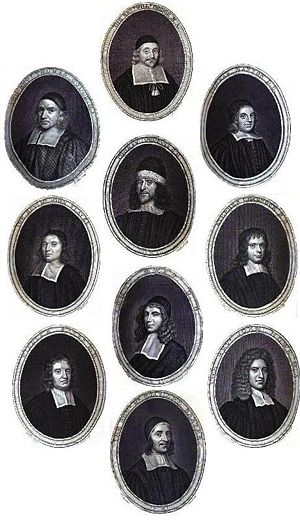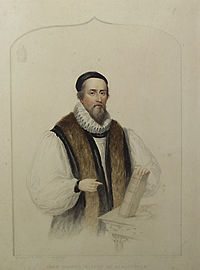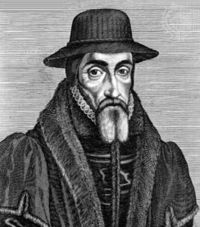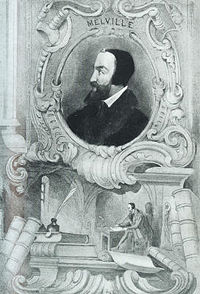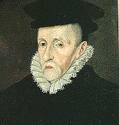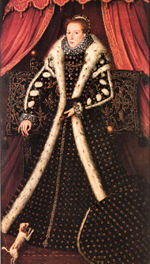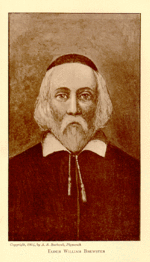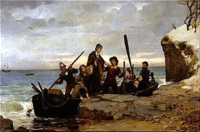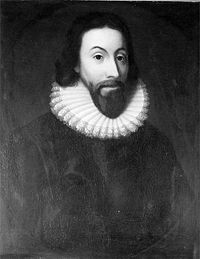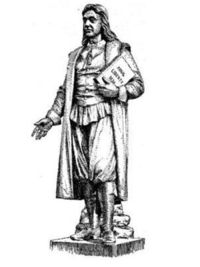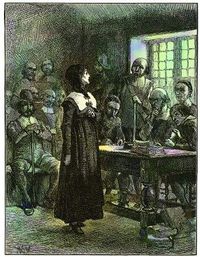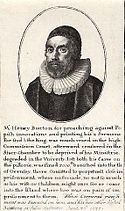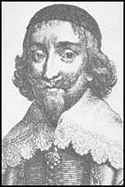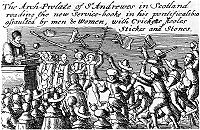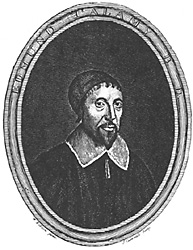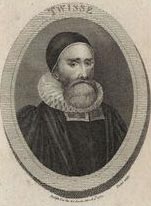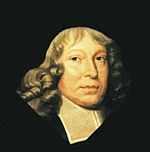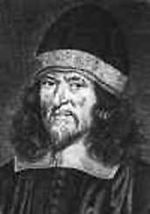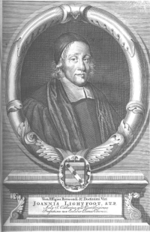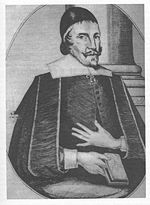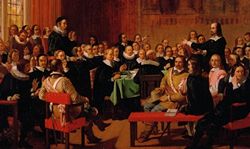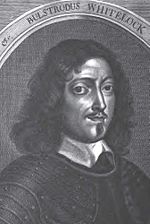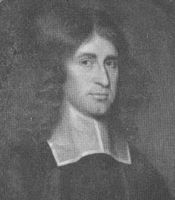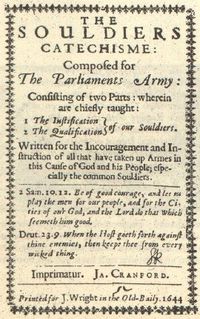Puritan
2008/9 Schools Wikipedia Selection. Related subjects: British History 1500-1750
A Puritan of 16th and 17th century England was an associate of any number of disparate religious groups advocating for more "purity" of worship and doctrine, as well as personal and group piety. Puritans felt that the English Reformation had not gone far enough, and that the Church of England was tolerant of practices which they associated with the church of Rome. The word "Puritan" was originally an alternate term for "Cathar" and was a pejorative used to characterize them as extremists similar to the Cathari of France. The Puritans sometimes cooperated with presbyterians, who put forth a number of proposals for "further reformation" in order to keep the Church of England more closely in line with the Reformed Churches on the Continent.
Background
The Puritan movement can be traced back to the Vestments Controversy in the reign of Edward VI, although the term "Puritan" was not coined until the 1560s, when it appears as a term of abuse for those who proposed further reforms than those adopted by the Elizabethan Religious Settlement of 1559. Throughout the reign of Elizabeth I, the Puritan movement involved both a political and a social component. Politically, the movement attempted, mostly unsuccessfully, to have Parliament pass legislation to replace episcopacy with presbyterianism, and to alter the 1559 Book of Common Prayer to remove elements considered odious by the Puritans. Socially, the Puritan movement called for a greater commitment to Jesus Christ on the part of its members and for greater levels of personal holiness. By the end of Elizabeth's reign, the Puritans constituted a distinct social group within the Church of England who regarded themselves as the godly, and who held out little hope for their neighbours who remained attached to " popish superstitions" and worldliness. However, most Puritans were non-Separating Puritans who remained within the Church of England, and only a small number of Puritans became Separating Puritans or Separatists who left the Church of England altogether. Although the Puritan movement was occasionally subjected to suppression by the bishops of the Church of England, in many places, individual ministers were able to omit disliked portions of the Book of Common Prayer and to be especially attentive to the needs of the godly.
Congregationalism
The Church of England as a whole was Calvinist, as seen in the 39 Articles, the Anglican Homilies, and in John Calvin's correspondence with Edward VI and Thomas Cranmer. The Puritan movement was distinctive from the rest of the church in theology more prescriptive than Calvinism, in legalism, theonomy, and especially – congregationalism. Puritan worship was plain, resembling a secular lecture with women strictly segregated from men, and tight control was exercised over the personal habits of members of Puritan congregations to enforce piety. Theology was clearly rooted in the humanism of the Age of Enlightenment. Puritans were dismayed in 1625 when Charles I became king and was determined to eliminate the "excesses" of Puritanism from the Church of England. His close advisor, William Laud, who became Archbishop of Canterbury in 1633, moved the Church of England in a direction away from Puritanism and rigorously enforced the law against ministers who deviated from the Book of Common Prayer, or who violated the ban on preaching about predestination. As a result, many Puritans participated in the Great Migration, founding the Massachusetts Bay Colony as a Puritan haven far from the prying eyes of Laud and the other bishops. The Puritan movement in England allied itself with the cause of "England's ancient liberties" - the unpopularity of Laud and the suppression of Puritanism was a major factor leading to the English Civil War, during which the Puritans formed the backbone of the parliamentary side.
Fragmentation
The Puritan movement began to fracture with the calling of the Westminster Assembly in 1643. Whereas previously, the Puritan movement was associated with Presbyterians and others that sought further reforms in the Church of England, at the Westminster Assembly, it became necessary to work out the details. Doctrinally, the Assembly was able to agree to the Westminster Confession of Faith (which thus provides a good overview of the Puritan theological position, although some Puritans would reject portions of it, e.g. the Baptists rejected its teaching on infant baptism). However, the Westminster Divines were bitterly divided over questions of church polity, and divided into factions supporting moderate episcopacy, presbyterianism, congregationalism, and Erastianism. Although the Assembly eventually decided on presbyterianism, the fact that Oliver Cromwell was an Independent who favoured religious toleration meant that presbyterianism was never imposed on the Church of England, resulting in the English Interregnum being a period of religious diversity and experimentation. At the time of the English Restoration (1660), the Church of England was also restored to its pre-Civil War constitution and the Puritans were again forced out of the Church of England by the Great Ejection of 1662. By this point, the term "Puritan" was replaced by the term Dissenter to describe those who "dissented" from the 1662 Book of Common Prayer. Forced from the Church of England, Dissenters established their own denominations in the 1660s and 1670s. The government initially attempted to suppress these organizations by the Clarendon Code. The Whigs argued that the Dissenters should be allowed to worship outside of the Church of England. This position ultimately prevailed when the Toleration Act was passed in the wake of the Glorious Revolution (1689). As a result, a number of denominations were legally organized in the 1690s. The term Nonconformist generally replaced the term "Dissenter" from the middle of the eighteenth century.
Terminology
Originally used to describe a third-century sect of strictly legalistic heretics, the word "Puritan" is now applied unevenly to a number of Protestant churches (and religious groups within the Anglican Church) from the late 16th century to the present. Puritans did not originally use the term for themselves. It was a term of abuse that first surfaced in the 1560s. "Precisemen" and "Precisions" were other early antagonistic terms for Puritans who preferred to call themselves "the godly." The word "Puritan" thus always referred to a type of religious belief, rather than a particular religious sect. To reflect that the term encompasses a variety of ecclesiastical bodies and theological positions, scholars today increasingly prefer to use the term as a common noun or adjective: "puritan" rather than "Puritan."
The single theological momentum most consistently defined by the term "Puritan" was Reformed or Calvinist and led to the founding of the Presbyterian, Baptist, and Independent or Congregationalist churches; In the United States, the church and religious culture of the Puritans of the Massachusetts Bay Colony formed the basis of post-colonial American Congregationalism, specifically the Congregational Church proper. The term Puritan was used by the group itself mainly in the 16th century, though it seems to have been used often and, in its earliest recorded instances, as a term of abuse. By the middle of the 17th century, the group had become so divided that "Puritan" was most often used by opponents and detractors of the group, rather than by the practitioners themselves. As Patrick Collinson has noted, well before the founding of the New England settlement, “Puritanism had no content beyond what was attributed to it by its opponents.” The practitioners knew themselves as members of particular churches or movements, and not by the simple term.
Puritans who felt that the Reformation of the Church of England had not gone far enough but who remained within the Church of England advocating further reforms are known as non-separating Puritans. (The Non-Separating Puritans differed among themselves about how much further reformation was necessary.) Those who felt that the Church of England was so corrupt that true Christians should separate from it altogether are known as separating Puritans or simply as Separatists. Especially after the Restoration (1660), non-separating Puritans were called Nonconformists (for their failure to conform to the Book of Common Prayer) while separating Puritans were called Dissenters.
The term "puritan" is not normally used to describe any religious group after the 17th century, although several groups might be called "puritan" because their origins lay in the Puritan movement. For example, in the late seventeenth century, those Dissenters who had separated from the Church of England organized themselves into separate denominations ( Presbyterians, Congregationalists, and Baptists), particularly after the Act of Toleration of 1689 made it legal to worship outside the Church of England. The non-separating Puritans who remained within the Church of England had by the early eighteenth century come to be known as the Low Church wing of the Church of England.
The term "puritan" might be used by analogy (usually unfavorably) to describe any group that shares a commitment to the Puritans' strong commitment to the purity of worship, of doctrine, or of personal or group morality.
History
Background, to 1559
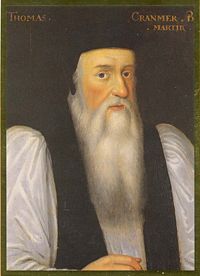
The English Reformation, begun in the reign of Henry VIII of England, was initially influenced by a number of reforming movements on the continent: Erasmian, Lutheran, and Reformed, while the practice of the Church of England continued to display many similarities with Roman Catholicism. In the reign of Henry’s son, Edward VI of England, the English Reformation began to take on a more distinctly Calvinist tone. This was particularly the case because, shortly after Edward ascended the throne, the forces of the Schmalkaldic League were defeated at the Battle of Mühlberg by the forces of Charles V, Holy Roman Emperor, which led to a number of leading Reformed churchmen seeking refuge in England. The refugees included Peter Martyr Vermigli (who became Regius Professor of Divinity at Oxford University), Martin Bucer (who became Regius Professor of Divinity at Cambridge University), and John a Lasco (who became head of the stranger churches).
All three of these men influenced England’s leading Protestant reformer, Archbishop of Canterbury Thomas Cranmer, the primate of the Church of England. On the issue of the eucharist (probably the most contentious theological issue of the day), Cranmer came to adopt the Reformed, rather than the Lutheran position. (At his trial, Cranmer said that he was influenced in this regard by Nicholas Ridley, Bishop of London, who in turn said that he was most influenced that the Calvinists were correct through his study of Ratramnus.) Cranmer’s views are important because he wrote his opinion into the Book of Common Prayer, which he revised several times during Edward’s reign. The 1552 version, in particular, incorporated many of Martin Bucer’s suggestions, as did the 1552 Forty-Two Articles. Thus, by 1552, the Church of England had moved decisively towards the Reformed camp, although its worship still retained several elements which had been changed by the continental Reformed churches (including the keeping of Lent, allowing the baptism of infants by midwives, retaining the custom of the churching of women, requiring the clergy to wear vestments, and requiring kneeling at Communion).
Of all the debates about the extent of reforms in England, the one which would ultimately prove to have the longest staying power was the debate about whether the clergy should be required to wear vestments. In his 1550 Lenten sermons before the king, John Hooper called for the elimination of vestments. Later that year, Hooper was to be appointed Bishop of Gloucester, but refused on the grounds that he would be required to wear vestments. Called before the English privy council, a deal was worked out whereby Hooper could be excused from wearing vestments, provided he allowed the clergy under him to wear vestments if they saw fit. Cranmer ordered Nicholas Ridley to perform the consecration of Hooper as Bishop of Gloucester on the basis of the deal worked out in the Privy Council; Ridley, however, refused, on the grounds that such a consecration would violate the ordinal of the Book of Common Prayer, which, since it had been passed by the English Parliament and signed by the king, was the law of the land. This disagreement led to a subsequent October 1550 debate between Hooper and Ridley which formed the basis of the Vestments Controversy (also known as the "Vestiarian Controversy"). In December, Hooper was placed under house arrest for refusing to be consecrated as a bishop, which was a crime under the terms of the 1549 Act of Uniformity. In January 1551, Peter Martyr Vermigli visited Hooper to encourage him to wear vestments, and John Calvin wrote him a letter saying that, while he agreed with Hooper’s position on vestments, the issue was not a big enough deal to justify his refusing the bishopric.
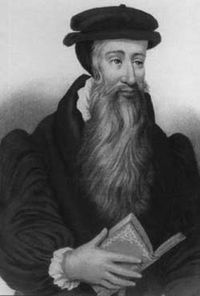
As such, in February, Hooper ended his resistance, and he was subsequently consecrated as Bishop of Gloucester in March 1551.
Throughout the reign of Edward VI, the Church of England had been steadily moving toward the Reformed position. This was halted in 1553, when Edward died and his Catholic half-sister assumed the throne as Mary I of England. Mary determined to end the English Reformation and restore the Church of England to full communion with the Church of Rome, and therefore instituted a series of persecutions of Protestants known as the Marian Persecutions, which saw Thomas Cranmer, Nicholas Ridley, John Hooper, and many other prominent English Protestants burned at the stake.
As a result of the persecution, roughly 800 English Protestants went into exile. Unwelcome in German Lutheran territories, they established English Protestant congregations in Emden, Wesel, Frankfurt, Strasbourg, Zurich, Basel, Geneva, and Aarau. Most of these churches continued to follow the 1552 Book of Common Prayer, but the Frankfurt congregation, under the leadership of John Knox, felt that the 1552 Book of Common Prayer was insufficiently reformed, and therefore worshiped according to a liturgy drawn up by Knox, known as the Book of Common Order. Under this liturgy, the clergy did not wear vestments, which led to a renewal of the Vestments Controversy between the Frankfurt congregation and the other English Marian exiles.
Reign of Elizabeth I, 1559-1603
The Elizabethan Religious Settlement, 1559
In 1559, Queen Mary died, and her half-sister, Elizabeth became Queen of England. Elizabeth had been raised as a Protestant in the household of Catherine Parr and upon her ascension to the throne, Elizabeth was determined to reverse Mary's policies and make England a Protestant nation. The first year of Elizabeth's reign was a difficult one: on the one hand, the Marian exiles on the continent returned to England, expecting to thoroughly reform the Church of England; on the other hand, a large proportion of the population and the political nation of England had supported Mary's Catholic policies. The result in 1559 was a compromise between the two positions, known as the Elizabethan Religious Settlement, which attempted to make England Protestant without totally alienating the portion of the population that had supported Catholicism under Mary. While the Elizabethan Settlement proved acceptable to the vast majority of the English nation, there remained minorities at either extremes who were dissatisfied with the state of the Church of England - deeply committed Catholics complained that the Church of England had strayed too far from the Church of Rome, while deeply committed Protestants complained that the Church of England retained far too many remnants of Roman Catholicism and was therefore in need of "further reform". This cry for "further reform" in the 1560s was the basis of the Puritan Movement.
The Church of England under Elizabeth was broadly Reformed in nature: Elizabeth's first Archbishop of Canterbury, Matthew Parker had been the executor of Martin Bucer's will, and his replacement, Edmund Grindal had carried the coffin at Bucer's funeral. During the 1560s and 1570s, the works of John Calvin were the most widely disseminated publications in England, while the works of Theodore Beza also enjoyed immense popularity. As a result, the bishops who opposed Puritanism in the sixteenth and early-seventeenth century were themselves thoroughly Calvinist.
Matthew Parker, Archbishop of Canterbury, 1559-1575

The Return of the Vestiarian Controversy, 1563-1569
At the first Convocation of the English Clergy of Elizabeth's reign, held in 1563, the Puritan faction of the Church of England set out its desires for further reforms: 1) a reduction in the number of saints' days; 2) the elimination of vestments; 3) the elimination of kneeling at communion; 4) the elimination of "emergency baptism" of sickly newborns; and 5) the elimination of organs from churches. The Puritan faction achieved none of its goals at the 1563 Convocation, though many Puritan clergymen introduced these reforms in their congregations on their own initiative in the following years. For example, at Cambridge, William Fulke convinced his students not to wear their surplices and to hiss at those students who wore their surplices.
In this situation, Archbishop Parker published a set of Advertisements, requiring uniformity in clerical dress. The Puritan faction objected loudly, and appealed to the continental reformers to support their cause. Unfortunately for the Puritans many of the continental reformers felt that the Puritans were just making trouble - for example, in a letter to Bishop Grindal, Heinrich Bullinger accused the Puritans of displaying "a contentious spirit under the name of conscience". Grindal proceeded to publish the letter without Bullinger's permission. Theodore Beza was more supportive of the Puritan position, though he did not intervene too loudly because he feared angering the queen and he wanted the queen to intervene in France on behalf of the Huguenots. In response to clergymen refusing to wear their vestments, 37 ministers were suspended. In response, in 1569, some ministers began holding their own services, the first example of Puritan separatism.
The Admonition to the Parliament (1572) and the Demand for Presbyterianism
Throughout the 1560s, England's return to Protestantism had remained tentative, and large numbers of the people remained committed to Catholicism and sought a return to Catholicism. Three events around 1570 led to a re-enforcement of Protestantism: (1) The Rising of the North, when the northern earls revolted, demanding a return to Catholicism; (2) Pope Pius V issued the bull Regnans in Excelsis, absolving Catholics of their duty of allegiance to Elizabeth; and (3) the Ridolfi plot sought to replace Elizabeth with the Catholic Mary, Queen of Scots. In response to this Catholic rebelliousness, the English government took several measures to shore up the Protestantism of the regime: (1) all clergymen were required to subscribe to the Thirty-Nine Articles; (2) all laity were required to take communion according to the rite of the Book of Common Prayer in their home parish at least once a year; and (3) it became a treasonable offense to say that the queen was a heretic or a schismatic.
In this pro-Protestant, anti-Catholic environment, the Puritan faction sought to push further reforms on the Church of England. John Foxe and Thomas Norton presented a reform proposal initially drawn up under Edward VI to Parliament. Elizabeth quickly killed this proposal, however, insisting on adherence to the 1559 religious settlement. Meanwhile, at Cambridge, professor Thomas Cartwright, a long-time opponent of vestments, offered a series of lectures in 1570 on the Book of Acts in which he called for the abolition of episcopacy and the creation of a presbyterian system of church governance in England.
Puritans were further dismayed when they learned that the bishops had decided to merge the vestiarian controversy into the requirement that clergy subscribe to the Thirty-Nine Articles: at the time they swore their allegiance to the Thirty-Nine Articles, the bishops also required all clergymen to swear that the use of the Book of Common Prayer and the wearing of vestments are not contrary to Scripture. Many of the Puritan clergymen were incensed at this requirement. A bill authorizing the bishops to permit deviations from the Book of Common Prayer in cases where the Prayer Book required something contrary to a clergyman's conscience was presented and defeated at the next parliament.
Meanwhile, at Cambridge, Vice-Chancellor John Whitgift moved against Thomas Cartwright, depriving Cartwright of his professorship and his fellowship in 1571.
Under these circumstances, in 1572, two London clergymen - Thomas Wilcox and John Field - penned the first classic expression of Puritanism, their Admonition to the Parliament. According to the Admonition, the Puritans had long accepted the Book of Common Prayer, with all its deficiencies, because it promoted the peace and unity of the church.

However, now that the bishops were requiring them to subscribe to the Book of Common Prayer, the Puritans felt obliged to point out the popery and superstition contained in the Prayer Book. The Admonition went on to call for more thorough church reforms, modeled on the reforms made by the Huguenots or by the Church of Scotland under the leadership of John Knox. The Admonition ended by denouncing the bishops and calling for the replacement of episcopalianism with presbyterianism.
The Admonition to Parliament set off a major controversy in England. John Whitgift wrote an Answer denouncing the Admonition which in turn led to Thomas Cartwright's Replye to An Answere Made of M. Doctor Whitgift Agaynste the Admonition to the Parliament (1573), a second Puritan classic. Cartwright argued that a properly reformed church must contain the four orders of ministers identified by Calvin: teaching elders, ruling elders, deacons, and theological professors. Cartwright went on to denounce the subjection of any minister in the church to any other minister in the strongest possible terms. In a Second Replye, Cartwright was even more forceful, arguing that any preeminence accorded to any minister in the church violated divine law. Furthermore, he went on to assert that a presbyterian hierarchy of presbyteries and synods was required by divine law.
In 1574, an ally of Cartwright's, Walter Travers published a Full and Plaine Declaration of Ecclesiasticall Discipline, setting forth a scheme of reform in greater detail than Cartwright had.
The government moved against all three of these Puritan leaders: John Field and Thomas Wilcox were imprisoned for a year, while Thomas Cartwright fled to exile on the continent to avoid such a fate. In the end, however, the number of clergymen who refused to subscribe to the bishops' requirements proved to be too large, and a number of qualified subscriptions were allowed.
Edmund Grindal, Archbishop of Canterbury, 1575-1583
The reign of Edmund Grindal as Archbishop of Canterbury (1575-1583) was relatively tranquil compared to that of his predecessor, mainly because the movement had been so effectively stifled during Archbishop Parker's tenure.
The major issue during Grindal's archiepiscopate came in 1581, when Robert Browne and his congregation at Bury St Edmunds withdrew from communion in the Church of England, citing the Church of England's dumb (i.e. non-preaching) ministry, and the lack of proper church discipline. Browne and his followers, known as the Brownists, were forced into exile in the Low Countries. There, they were encouraged by Thomas Cartwright, who was now serving as minister to the Merchant Adventurers at Middelburg. However, Cartwright argued that while the Church of England might be flawed, the Brownists were incorrect in separating from it (i.e. he opposed separatism). Like the vast majority of Puritans, Cartwright advocated further reforms to the Church of England, while rejecting the separatism of the Brownists.
A second Puritan development under Grindal was the rise of the Puritan conventicle, modeled on the Zurich Prophezei (Puritans learned of the practice through the congregation of refugees from Zurich established in London), where ministers met weekly to discuss "profitable questions." These "profitable questions" included the correct use of the Sabbath, a sign of the growth of the characteristically English Sabbatarianism of the English Puritans. The queen objected to the growth of the conventicling movement and ordered Archbishop Grindal to suppress the movement. Archbishop Grindal refused, citing I Cor. 14. As a result of his disobedience, Grindal was disgraced and placed under virtual house arrest for the rest of his tenure as Archbishop of Canterbury. However, because of his actions, the conventicles resumed after a brief period of suspension.
John Whitgift, Archbishop of Canterbury, 1583-1604
As we saw above, John Whitgift had been a vocal opponent of Thomas Cartwright. He believed that the matter of church governance was adiaphora, a "matter indifferent", and that the church should accommodate its governance style to the style of government in the state in which the church was located. The Church of England was located in a monarchy, so the church should adopt an episcopal style of government.
Renewed calls for Presbyterianism
The years 1583-1585 saw the brief ascendancy in Scotland of James Stewart, who claimed the title of Earl of Arran. This period saw Scotland pass the Black Acts, which outlawed the Second Book of Discipline. As a response, many Scottish ministers, including Andrew Melville, sought refuge in England. These refugees participated in the English conventicles (as did John Field, now released from prison) and convinced many English Puritans that they should renew their fight to establish presbyterianism in England. As such, in the 1584 Parliament, Puritans introduced legislation to replace the Book of Common Prayer with the Genevan Book of Order and to introduce presbyterianism. This effort failed.
At this point, John Field, Walter Travers, and Thomas Cartwright were all free and back in England and determined to draft a new order for the Church of England. They drafted a Book of Discipline, which circulated in 1586, and which they hoped would be accepted by the 1586 Parliament. Again, the Puritan effort failed in Parliament.
Martin Marprelate, 1588-89, and response
In 1588-89, a series of virulently anti-episcopal tracts were published under the pseudonym of Martin Marprelate. These Marprelate tracts, published by Welsh publisher John Penry, denounced the bishops as agents of Antichrist, the strongest possible denunciation for Christians. The Marprelate tracts called the bishops "our vile servile dunghill ministers of damnation, that viperous generation, those scorpions."
Unforunately for the Puritans, the mid- to late-1580s saw a number of the defenders of the Puritans in the English government die: Francis Russell, 2nd Earl of Bedford in 1585; Robert Dudley, 1st Earl of Leicester in 1588; and Francis Walsingham in 1590. In these circumstances, Richard Bancroft (John Whitgift's chaplain) led a crackdown against the Puritans. Cartwright and eight other Puritan leaders were imprisoned for eighteen months, before facing trial in the Star Chamber. The conventicles were disbanded.
Some Puritans followed Robert Browne's lead and withdrew from the Church of England. A number of those separatists were arrested in the woods near Islington in 1593, and John Greenwood and Henry Barrowe were executed for advocating separatism. Followers of Greenwood and Barrowe fled to the Netherlands, and would form the basis of the Pilgrims, who would later found the Plymouth Colony.
1593 also saw the English parliament pass the Religion Act (35 Elizabeth c. 1) and the Popish Recusants Act (35 Elizabeth c. 2), which provided that those worshiping outside the Church of England had 3 months in which to either conform to the Church of England or else abjure the realm, forfeiting their lands and goods to the crown, with failure to abjure being a capital offense. Although these acts were directed against Roman Catholics who refused to conform to the Church of England, on their face they also applied to many of the Puritans. Although no Puritans were executed under these laws, they remained a constant threat and source of anxiety to the Puritans.
The Drive to Create a Preaching Ministry
One of the most important aspects of the Puritan movement was its insistence on having a preaching ministry throughout the country. At the time of the Elizabethan Religious Settlement, less than 10% of the 40,000 English parish clergy was licensed to preach. (Since the time of the repression of the Lollards in the 14th century, it had been illegal for an ordained parish priest to preach to his congregation without first obtaining a license from his bishop.) Elizabeth herself had been no fan of preaching and preferred a church service focused on the Prayer Book liturgy. However, many of Elizabeth's bishops did support the development of a preaching ministry, and aided by wealthy laymen, were able to dramatically expand the number of qualified preachers in the country. For example, Sir Walter Mildmay founded Emmanuel College, Cambridge in 1584 to promote the training of preaching ministers. Frances Sidney, Countess of Sussex similarly founded Sidney Sussex College, Cambridge in 1596. Emmanuel and Sidney Sussex became the homes of academic Puritanism.
Although the number of preachers increased dramatically over the course of Elizabeth's reign, there were still not enough preachers to go around. A layman who wanted to hear a sermon might have to travel to another parish in order to find one with a preaching minister. When he got there, he might find that the preaching minister had shortened the Prayer Book service to allow more time for preaching. And, as a trained minister, when he did pray, he was more likely to offer an extemporaneous prayer instead of simply reading the set prayer out of the Prayer Book. Thus we see two different styles developing in the Church of England: a traditional style, focused on the liturgy of the Book of Common Prayer; and the Puritan style, focused on preaching, with less ceremony and shorter or extemporaneous prayers.
The rise of "experimental predestinarianism"
Following the suppression of Puritanism in the wake of the Marprelate Tracts, Puritans in England assumed a more low-key approach in the 1590s. Ministers who favoured further reforms increasingly turned their attention away from structural reforms to the Church of England, instead choosing to focus on individual, personal holiness. Theologians such as William Perkins of Cambridge continued to maintain the rigorously high standards of previous Puritans, but now focused their attention on improving individual, as opposed to collective, righteousness. A characteristic Puritan focus during this period was for more rigorous keeping of the Christian Sabbath. William Perkins is also credited with introducing Theodore Beza's version of double predestination to the English Puritans, a view which he popularized through the use of a chart he created known as "The Golden Chain".
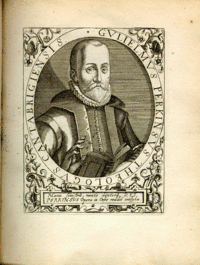
In 1970, R. T. Kendall labeled the form of religion practiced by William Perkins and his followers as experimental predestinarianism, a position which Kendall contrasted with credal predestinarianism. Kendall identified credal predestinarians as anyone who accepts the Calvinist teaching on predestination. Experimental predestinarians, however, went beyond merely adhering to the doctrine of predestination, but in fact taught that it was possible for individuals to know experimentally that one is saved, a member of God's elect predestined for eternal life. (The credal predestinarians believed that only some group was destined for eternal life, but that it was impossible in this life to identify who is elect and who is reprobate.) Puritans who adopted Perkins' brand of experimental predestinarianism felt pressure, once they had undergone a religious process to attain knowledge of their election, to seek out like-minded individuals who had undergone similar religious experiences.
In time, some Puritan clergymen and laity, who increasingly referred to themselves as "the godly", began to view themselves as distinct from the regular members of the Church of England, who had not undergone an emotional conversion experience. At times, this tendency led for calls for "the godly" to separate themselves from the Church of England. While the majority of Puritans remained "non-separating Puritans", they nevertheless came to constitute a distinct social group within the Church of England by the turn of the seventeenth century. In the next reign, "the Puritan" as a type was common enough that playwright Ben Jonson could satirize Puritans in the form of the characters Tribulation and Ananais in The Alchemist (1610) and Zeal-of-the-land Busy in Bartholomew Fair (1614).
Reign of James I, 1603-1625
The Millenary Petition (1603) and the Hampton Court Conference (1604)
Elizabeth I died in March 1603, whereupon James VI of Scotland, who had been King of Scots since the abdication of his mother, Mary, Queen of Scots in 1567 (when James was 1 year old), inherited the English throne. James had had little contact with his mother and was raised by guardians in the Presbyterian Church of Scotland. John Knox had led the Scottish Reformation, beginning in 1560, and the Church of Scotland looked broadly like the type of church that the Puritans wanted in England. As such, the Puritans hoped that the further reforms which had been blocked under Elizabeth could now be carried out under the new king. They were somewhat worried because in his 1599 book Basilikon Doron, the king had had harsh words for Puritans. However, his criticisms seemed directed at the most extreme of the Puritans and it seemed likely that the king would agree to at least the more moderate Puritan reforms.
Thus, throughout 1603, Puritan ministers collected signatures for a petition, known as the Millenary Petition because it was signed by 1,000 Puritan ministers. The Petition was careful not to challenge the royal supremacy in the Church of England, and called for a number of moderate church reforms to remove ceremonies perceived as overly popish: 1) the use of the sign of the cross in baptism (which Puritans saw as superstitious); 2) the rite of confirmation (which Puritans criticized because it was not found in the Bible); 3) the performance of baptism by midwives (which Puritans argued was based on a superstitious belief that infants who died without being baptized could not go to heaven); 4) the exchanging of rings during the marriage ceremony (again seen as unscriptural and superstitious); 5) bowing at the Name of Jesus during worship (again seen as superstitious); 6) the requirement that clergy wear vestments (see above); and 7) the custom of clergy living in the church building. The Petition argued that a preaching minister should be appointed to every parish (instead of one who simply read the service from the Book of Common Prayer). In opposition to Archbishop Whitgift's policy that clergy must subscribe to the Book of Common Prayer and the use of vestments, the Petition argued that ministers should only be required to subscribe to the 39 Articles and the royal supremacy. Finally, the Petition called for the ending of episcopacy, and the setting up of a presbyterian system of church governance.
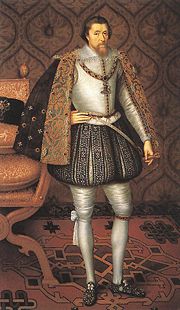
James I, who had studied theology, and who enjoyed debating theological points, agreed to hold a conference at Hampton Court Palace, where supporters and opponents of the Millenery Petition could debate the merits of reforms to the church. After being postponed due to an outbreak of the plague, the Hampton Court Conference was held in January 1604. The king chose four Puritans to represent the Puritan cause: John Rainolds (president of Corpus Christi College, Oxford), Laurence Chaderton (master of Emmanuel College, Cambridge), Thomas Sparks, and John Knewstubs. Archbishop Whitgift led a delegation of eight bishops (including Whitgift's protege, Richard Bancroft, Bishop of London), seven deans, and two other clergymen in opposition to the Puritans.
At the first meeting of the Hampton Court Conference, held January 14, James met only with Archbishop Whitgift's party. On the second day, January 16, he met with the Puritans - this day of the conference ended badly for the Puritans when John Rainolds mentioned the Puritan proposal for creating presbyteries in England. James had long regarded bishops (who were appointed by the monarch) as the main instrument of royal power in the church, and viewed the proposal to replace bishops with presbyteries as an attempt to diminish his power in the church. As such, James issued his famous maxim "No bishop, no king!" on this occasion, before ending the day's meeting early. On January 18, the king initially met with Whitgift's party and an assemblage of ecclesiastical lawyers, before calling in the Puritans to hear his verdict. James declared that the use of the Book of Common Prayer was to continue, and made no provisions for a preaching ministry. He did, however, approve a few changes in the Book of Common Prayer: 1) the mention of baptism by midwives was to be eliminated; 2) the term " absolution" (which Puritans associated with the Catholic sacrament of penance, which was rejected by Protestants) was replaced by the term "remission of sins"; 3) confirmation was renamed "laying on of hands" to dissociate it from its Catholic sacramental meaning; and 4) a few other minor changes. James also announced that he agreed to support the Puritan project for a new, authorized translation of the Bible, thus setting the stage for the production of the Authorized King James Version of the Bible, which would ultimately be published in 1611.
Richard Bancroft, Archbishop of Canterbury, 1604-1610
The Puritans were further disappointed when, following the death of John Whitgift, James selected Richard Bancroft as his replacement as Archbishop of Canterbury. Bancroft had argued against the Puritans at the Hampton Court Conference, and his selection signaled that James would not be willing to go ahead with any further reforms. Shortly after his selection, Bancroft presented a book of canons to the Convocation of the English Clergy - these canons received royal approval and as such became part of the Church of England's canon law. This outraged the Parliament of England, which in 1559 had passed the Act of Uniformity approving the Book of Common Prayer, and which claimed that Parliament, not Convocation, was the only body authorized to pass new canon law. The Puritans, who opposed Bancroft's book of canons, argued that the bishops were attempting to aggrandize themselves at the Parliament's expense. In the end, James acceded to Parliament's demand, and withdrew the book of canons. The 1604 parliament marks the first time that the Puritans had allied themselves with the cause of Parliament over against the cause of the bishops. Over the next several decades, this alliance would become one of the most pronounced features of English politics, and would form the basis of the divisions in the English Civil War in the 1640s.
The discovery of the Gunpowder Plot (a plot by Guy Fawkes to kill the king and parliament by bombing the State Opening of Parliament in order to restore Catholicism in England) led to a period of particularly virulent anti-Catholicism. Since the Puritans were the most passionately anti-Catholic group in England, they enjoyed some cachet in this period. Nevertheless, their reform proposals were always successfully blocked by Archbishop Bancroft.
George Abbot, Archbishop of Canterbury, 1611-1633
Following Archbishop Bancroft's death in 1610, James chose George Abbot as his successor. James had been trying to bring the Church of England and the Church of Scotland closer together, in the hope that the two churches might eventually merge. James re-introduced bishops (abolished at the time of the Scottish Reformation) into the Church of Scotland, though with less power than bishops elsewhere, with the Scottish bishops serving essentially as the permanent chairman of their presbytery (so that the presbyterian structure of the church was essentially maintained). In 1608, Abbot had impressed James after he accompanied George Home, 1st Earl of Dunbar to Scotland as part of his efforts to unify the English and Scottish churches, and James had named Abbot Bishop of Lichfield in 1609. James intended Abbot's appointment as Archbishop of Canterbury to further his project of unifying the English and Scottish churches.
While every Archbishop of Canterbury since Matthew Parker had been a Calvinist, Abbot is generally regarded as "The Calvinist Archbishop" or even as "The Puritan Archbishop", and is the closest the Puritans ever got to seeing an Archbishop of Canterbury endorse their proposals. (The one issue on which Abbot was distinctly non-Puritan was the issue of episcopacy - Abbot was one the most vocal proponents of the doctrine of Apostolic Succession in the Church of England.)
The Book of Sports Controversy, 1617
As has been noted earlier, one of the characteristic features of the Puritan movement was an insistence on a strict keeping of the Christian Sabbath on Sundays. (Of all the Reformed movements on the continent, none ever came anywhere close to the Puritans' extreme Sabbatarianism.) The Puritans insisted that the Fourth Commandment (which Catholics and Lutherans regard as the Third Commandment) of the Ten Commandments required not only that no work be performed on Sundays, but also that the entire day should be dedicated to the worship of God.
It had long been a custom in England that Sunday mornings were dedicated to Christian worship, and were then followed by sports and games on Sunday afternoons. The Puritans loudly objected to the practice of Sunday sports, believing that playing games on the Sabbath constituted a violation of the Fourth Commandment.
In the early seventeenth century, Puritans came to dominate several localities and managed to succeed in banning Sunday sports. In 1617, in Lancashire, there was a particularly intense quarrel between the Puritans and the local gentry (many of whom were Catholic recusants) over the issue of Sunday sports. In response to the controversy raging in his diocese, Thomas Morton, Bishop of Chester, asked the king for a ruling on the propriety of Sunday sports.
In response to Bishop Morton's request, King James issued the Book of Sports, a declaration declaring that it was lawful to play some sports on Sundays, but not others. Criticizing the opinions of "puritans and precise people", the Book listed archery, dancing, " leaping, vaulting, or any other such harmless recreation" as permissible sports for Sundays. It forbade bear-baiting, bull-baiting, "interludes" and bowling.
Needless to say, the Book of Sports was very controversial among the Puritans. The king commanded all Anglican ministers to read the Book of Sports to their congregations, but Archbishop Abbot, a supporter of Sabbatarianism, ordered his clergy not to read the Book of Sports.
The Five Articles of Perth, 1618
As part of his policy of moving the English and Scottish churches closer together, in 1618, King James proposed the Five Articles of Perth, which imposed English practices on the Scottish church. The Five Articles required 1) kneeling at Communion; 2) provisions allowing for private baptism; 3) provisions allowing reservation of the sacrament for the ill; 4) only a bishop was allowed to administer the rite of confirmation; and 5) the Church of Scotland, which had previously abolished all holy days, was obliged to accept some holy days.
The Five Articles of Perth were ultimately accepted by the General Assembly of the Church of Scotland, though a sizable minority of Scottish Presbyterians objected. The Articles of Perth were also distressing for English Puritans - the Puritans had hoped that the Church of England would be reformed to be brought in line with the practice of the Church of Scotland. Instead, the Articles of Perth appeared to English Puritans to be heading in the wrong direction, by forcing English errors on the Church of Scotland.
Controversy over the Spanish Match, 1623-1624

King James saw himself as the potential peacemaker of Europe, and his propaganda portrayed him as the modern Solomon. In addition to attempting to reconcile the Church of Scotland and the Church of England, James hoped that he would be able to reconcile Catholic and Protestant Europe. (This is part of the reason why he favoured the Church of England over the Church of Scotland while pursuing his reforms - he felt that the Church of England could provide a model middle ground, and that both Catholics and Protestants would be able to accept churches modeled after the Church of England. In this regard, he subscribed to the theory that the Church of England represented a via media, a middle way between Protestantism and Catholicism, a view first propounded by Richard Hooker in the reign of Elizabeth I.) As such, when his son Charles became old enough to marry, James mused about marrying Charles to a Catholic princess in order to further his reconciliation of Catholicism and Protestantism.
James' opinions about the possibility of a reconciliation of Catholicism and Protestantism were challenged by the outbreak of the Thirty Years' War in 1618, a war which would prove to be the biggest Protestant-Catholic war since the sixteenth century (which had seen the Schmalkaldic War, the French Wars of Religion, etc.) and which thus signaled the end of two decades of relative Catholic-Protestant peace. The outbreak of the Thirty Years' War was particularly tragic for James since it was caused by the actions of his son-in-law Frederick V, Elector Palatine, who was married to James' daughter Elizabeth.
With the outbreak of war against the Catholics, English Protestants - and especially the English Puritans - demanded that James intervene on behalf of his son-in-law. James initially refused, but after Fredrick was ousted as King of Bohemia by Ferdinand II, Holy Roman Emperor in 1620, the clamor for English intervention grew so loud that James was forced to call a parliament to raise funds to support an expedition on behalf of Frederick (the first parliament James had called since the 1614 Addled Parliament). Unfortunately for James, Parliament, ably led by Edward Coke, refused to grant adequate funds for this expedition unless the king agreed that his son would marry a Protestant. James responded that Parliament had no business interfering in matters of royal prerogative. Parliament responded by passing a protest, asserting its ancient rights. At the urging of his favourite, George Villiers, 1st Duke of Buckingham, and of the Spanish ambassador Diego Sarmiento de Acuña, conde de Gondomar, James tore this protest out of the record book and dissolved Parliament.
Buckingham had gained considerable influence, not only over James, but also over Prince Charles. In 1623, he convinced the 23-year-old Prince Charles that England should ally with Spain and that Prince Charles should marry a Spanish princess. The two thus sailed for Spain so that Charles could court Maria Anna of Spain, daughter of Philip III of Spain. This proposed marriage is known to history as the Spanish Match. The Spanish Match was wildly unpopular among English Protestants, and allowed the Puritans a great deal of credibility. Puritans argued that the Spanish Match was part of a plot to restore England to Catholicism, a position that was deeply unpopular in England. As such, when James called another parliament in 1623, the anti-Catholic outpouring was so virulent that it was obvious the parliament would agree to none of the king's requests. Meanwhile, in Spain, the Spanish insisted that they would only agree to the Spanish Match if Charles agreed to convert to Catholicism and agree to spend a year receiving Catholic instruction in Spain. Under the circumstances, Charles ultimately declined the Spanish Match in 1624. His return to England was greeted with widespread celebrations and treated as a national holiday, celebrating the fact that the Spanish Match had not occurred.
In response to his rebuff by Spain, Charles came to favour alliance with France and war with Spain. At the Puritan-dominated 1624 parliament, the parliament impeached Lionel Cranfield, 1st Earl of Middlesex, the minister most associated with advocacy in favour of the Spanish Match. The parliament agreed to fund a war with Spain in principle, though they did not actually allocate funding for the war.
The rise of the Arminian party and the New Gagg controversy (1624)
As noted earlier, King James had been a doctrinal Calvinist all his life. Therefore, when the Quinquarticular Controversy broke out in the Dutch Republic in the years following the death of theologian Jacobus Arminius in 1609, James naturally supported the Calvinist Gomarists against the Arminian Remonstrants. James handpicked the British delegates to the 1618 Synod of Dort (whose five canons form the basis of the Five Points of Calvinism) and concurred in the outcome of the Synod.
However, as James was increasingly faced with Puritan opposition (over the Book of Sports, the Five Articles of Perth, the Spanish Match, etc.), he grew disillusioned with the Puritans, and began to seek out Church of England clergymen who would be more supportive of his ecumenical ecclesiastical plans.
Since the reign of Elizabeth, England had contained a number of theologians who opposed the extreme predestinarian views in the high Calvinism propounded by Theodore Beza and accepted by the Puritans. For example, Peter Baro, the Lady Margaret's Professor of Divinity at the University of Cambridge had opposed Archbishop Whitgift's attempts to impose the Calvinistic Lambeth Articles on the Church of England in 1595. Several of Baro's disciples at Cambridge - notably Lancelot Andrewes, John Overall, and Samuel Harsnett - had repeated Baro's criticisms of predestination in terms roughly equivalent to those propounded by Arminius. As such, when James was looking for anti-Puritan allies, he found this party willing, and, although few members of this party actually accepted the Arminian position tout court, they were quickly labeled "the Arminian party" by the Puritans.
This came to a head in 1624, when a hitherto obscure Cambridge scholar, Richard Montagu, obtained royal permission to publish A New Gagg for an Old Goose. The book was framed as a rebuttal of a Catholic critique of the Church of England. In response, Montagu argued that the Calvinist positions objected to were held only by a small, Puritan minority in the Church of England, and that the vast majority of clergy in the Church of England rejected high Calvinism. A New Gagg was incredibly important in the history of the Puritans in that it marked the first time the Puritans had ever been associated with a doctrinal position (as opposed to a question of proper practice). For example, George Carleton, Bishop of Chichester, who had been an English delegate at the Synod of Dort, was shocked to find his doctrinal position being equated with Puritanism.
Reign of Charles I, 1625-1649
Laudianism adopted as government policy
Prince Charles became King of England upon the death of his father in 1625. Charles was deeply distrustful of the Puritans (who had led a sustained opposition to his father's ecclesiastical policies), seeing them as rebellious (Charles, like his father,believed in the Divine Right of Kings). During the latter years of his reign, James, rebuffed by Parliament, had increasingly come to rely on clergymen of the "Arminian party" as political advisors and administrators. Charles accelerated this tendency. Charles had no particular interest in theological questions such as the doctrine of predestination, but he preferred the "Arminians'" emphasis on order, decorum, uniformity, and spectacle in Christian worship. He also appreciated their political point of view. In their preaching, the Arminians / Laudians endorsed the Divine Right of Kings. They argued that the king was appointed by God and was therefore responsible only to God for his actions. They argued that Parliament had a duty to pass the taxes which the king wanted because of their religious obligation to be obedient subjects of the king: this opinion flattered the king, and infuriated parliamentarians. The Laudians cast doubt on the political loyalties of the Puritans: had not Calvinists always proven themselves to be disloyal subjects? The Laudians pointed to the Scottish Reformation, which had been accomplished through open rebellion against Mary, Queen of Scots, and to the French Monarchomachs who openly defended tyrannicide. They argued that the Puritans were secretly opposed to royal power and would rebel at the first opportunity.
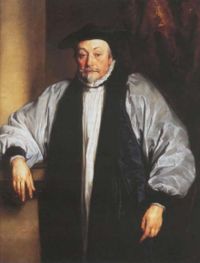
Besides the Duke of Buckingham, Charles' closest political advisor was William Laud, the Bishop of St David's, whom Charles translated to the more prestigious (and higher-paid) position of Bishop of Bath and Wells in 1626. Under Laud's influence, Charles shifted the royal ecclesiastical policy markedly. Whereas James had supported the Canons of the Synod of Dort, Charles forbade preaching on the subject of predestination altogether. Richard Montagu was made Bishop of Chichester in 1628. Whereas James had been lenient towards Puritan clergy who omitted parts of the Book of Common Prayer, Charles urged the bishops to strictly enforce compliance with the Prayer Book, and to suspend ministers who refused to comply.
The central ideal of Laudianism (the common name for the ecclesiastical policies pursued by Charles and Laud) was the "beauty of holiness" (a reference to Psalm 29:2). This emphasized a love of ceremony and harmonious liturgy. Many of the churches in England had fallen into disrepair in the wake of the English Reformation, especially in Puritan areas, since Puritans believed it was superstitious to attempt to beautify church buildings. Laudianism, however, called for making churches beautiful. Churches were ordered to make repairs and to enforce greater respect for the church building. A policy particularly odious to the Puritans was the installation of altar rails in churches, which Puritans associated with the Catholic position on transubstantiation (the idea that Christ becomes physically present in the consecrated host): in Catholic practice, altar rails served to physically demarcate the space where Christ became incarnate in the host and only priests, acolytes, and altar boys were allowed inside the altar rail. Since the Puritans rejected the idea of transubstantiation, and professed the priesthood of all believers, they objected to creating a physical space in the church where only priests could go. Further, they argued that the practice of receiving communion while kneeling at the rail too much resembled Catholic Eucharistic adoration, which they felt was a form of idolatry (since it involved offering the honour due to God to a piece of bread). The Laudians insisted on enforcing kneeling at communion and receiving at the rail, though they denied that this involved accepting the Catholic position on these points.
Puritans also objected to the Laudian insistence on calling members of the clergy " priests". In their minds, the word "priest" meant "someone who offers a sacrifice", and was therefore highly related in their minds to the Roman Catholic teaching that during the celebration of the Eucharist, a priest offers Christ (in the form of the communion wafer following transubstantiation) as a sacrifice. After the Reformation, the term " minister" (meaning "one who serves") was generally adopted by Protestants to describe their clergy. When the Laudians insisted on being called "priests", the Puritans were therefore highly critical, and therefore argued in favour of using the word "minister", or else simply transliterating the Koine Greek word presbyter used in the New Testament without translating it at all.
The Puritans were also dismayed when the Laudians insisted on the importance of keeping Lent, a practice which had been enforced by the government during Catholic times (it was, for example, a crime to eat meat during Lent), but which had fallen into disfavor in England after the Reformation. Although the Laudians did not advocate legislation to enforce Lent, they themselves engaged in fasting during Lent and encouraged others to do likewise. Many Puritans therefore argued that the Laudians were thereby re-introducing a superstition Catholic practice into the Church of England. Rather than observing seasonal fasts, Puritans favored fast days specifically called by the church of the government in response to the problems of the day, rather than fast days dictated by the ecclesiastical calendar.
Conflict between Charles I and the Puritans, 1625-1629
The controversy over Richard Montagu's New Gagg was still on parliamentarians' minds when Parliament met in May 1625. Furthermore, shortly before the opening of the parliament, Charles was married by proxy to Henrietta Maria of France, the Catholic daughter of Henry IV of France (thus cementing an alliance with France in preparation for war against Spain). As such, at this parliament, Puritan MPs openly worried that Charles was preparing to restrict the recusancy laws (which Charles was, in fact, planning on doing, having agreed to do so in the secret marriage treaty he negotiated with Louis XIII of France).
Puritan MP John Pym launched an attack on Richard Montagu in the House of Commons. As a response, Montagu wrote a pamphlet entitled Appello Caesarem (Latin "I Appeal to Caesar") (a reference to Acts 25:10-12), in which he appealed to Charles to protect him against the Puritans. Charles responded by making Montagu a royal chaplain, signaling that he was willing to defend Montagu against Puritan opposition.
In this atmosphere, Puritan suspicions that Charles was secretly planning to restore Roman Catholicism in England mounted. As such, the Parliament, heavily influenced by its Puritan members, was reluctant to grant Charles revenue, since they feared that any revenue granted might be used to support an army that would re-impose Catholicism on England. For example, since 1414, every English monarch had been authorized by their first Parliament to collect the customs duties of Tonnage and Poundage for the duration of their reign; the 1625 Parliament, however, voted to allow Charles to collect Tonnage and Poundage for only one year. Furthermore, when Charles wanted to intervene in the Thirty Years' War by declaring war on Spain, Parliament granted him only £140,000, a totally insufficient sum to pursue the war.
The war with Spain went ahead (partially funded by tonnage and poundage collected by Charles even after he was no longer authorized to do so). Buckingham was put in charge of the war effort, and failed miserably. As such, in 1628, Parliament called for Buckingham's replacement, but Charles stuck by Buckingham. Parliament went on to pass the Petition of Right, a declaration of Parliament's rights. Charles accepted the Petition, though this did not lead to a change in his behaviour.
In August 1628, Buckingham was assassinated by a disillusioned soldier, John Felton. The nation responded with spontaneous celebration, which angered Charles.
When Parliament resumed sitting in January 1629, Charles was met with outrage over the case of John Rolle, an MP who had been prosecuted for failing to pay Tonnage and Poundage even though Charles had agreed to "no taxation without representation" (to use a slogan from a later era) in the Petition of Right. John Finch, the Speaker of the House of Commons, was famously held down in the Speaker's Chair in order to allow the House to pass a resolution condemning the king.
Charles was so outraged by Parliament's opposition to his policies that he determined to rule without ever calling a parliament again, thus initiating the period known as his Personal Rule (1629-1640), which his enemies termed the Eleven Years' Tyranny. This period also saw the ascendancy of Laudianism in England (see previous section), which led Puritan critics to term this period the Caroline Captivity of the Church (a reference to the so-called Babylonian Captivity of the Church, which was itself a reference to the Babylonian Captivity).
The Great Migration and the foundation of Puritan New England, 1630-1642
The events of 1629 convinced many Puritans that King Charles was an ardent foe of further church reforms who would enforce Laudianism on the Church of England throughout his reign. Since King Charles was only 29 years old in 1629, they were thus faced with the prospect of countless decades without reforms and with their proposals being suppressed. Given this situation, some Puritans began considering founding their own colony where they could worship in a fully-reformed church, far from the prying eyes of King Charles and the bishops.
The Pilgrims (1620)
One group of Puritans had already settled in New England: the Pilgrims.
The Pilgrims were Separatists who held views similar to those proclaimed by Robert Browne, John Greenwood, and Henry Barrowe. The Pilgrims emerged in Elizabethan England at roughly the same time as the Brownists.
The Pilgrims trace their lineage to Richard Clyfton, minister of Babworth, Nottinghamshire. Beginning in the 1580s, Clyfton advocated separation from the Church of England. Clyfton's movement attracted William Brewster, the postmaster of Scrooby. Tobias Matthew, the Bishop of Durham, who had been part of Archbishop Whitgift's delegation at the Hampton Court Conference, was selected by James to become Archbishop of York in 1606. He led an anti-Separatist crackdown and Clyfton was removed from his ministry. In response, Brewster offered to organize a dissenting congregation in the manor house in which he lived in Scrooby. Clyfton served as the congregation's pastor, John Robinson as its teacher, and William Brewster as its chief elder. This congregation was subject to ecclesiastical investigation, and its members faced social hostility from conforming church members, but was not actively persecuted. Nevertheless, disliking the social hostility, and fearing future persecution, the group decided to leave England.
150 members of the congregation made it to Amsterdam, where they met up with a group of Separatist exiles led by John Smyth, which had joined the congregation of English exiles led by Francis Johnson. After a year at Amsterdam, tensions between Smyth and Johnson grew so high, that the Pilgrims decided to move to Leiden. While there, many worked at Leiden University or in the textile, printing and brewing trades. John Robinson participated in the Calvinist-Arminian Controversy while at Leiden University, arguing on behalf of the Gomarists.
By 1617, many members of the congregation had grown disillusioned with Leiden and wanted to move somewhere where they could retain their English identity, while also worshipping God in the way they believed was required. As such, the congregation voted to leave Leiden and to found a colony. The group ultimately decided to move to New England. In 1620, after receiving a patent from the London Company, the Pilgrims left for New England onboard the Mayflower, landing at Plymouth Rock. The colony founded by the Pilgrims was called Plymouth Colony.
John Winthrop and the foundation of the Massachusetts Bay Colony, 1630
The early seventeenth century saw the foundation of many joint stock companies, which were commercial ventures designed to profit from trade or the foundation of colonial settlements. The most famous of the joint stock companies was the Honourable East India Company, chartered in 1600. In 1606, King James had issued a royal charter to two companies referred to collectively as the Virginia Company: the London Company (which successfully established the Colony of Virginia in 1608) and the Plymouth Company (which was unsuccessful at establishing settlements, which explains why they were eager to grant a patent to the Pilgrims in 1620).
Two of the Pilgrim settlers in Plymouth Colony - Robert Cushman and Edward Winslow - believed that Cape Ann would be a profitable location for a settlement. They therefore organized a company which they named the Dorchester Company and in 1622 sailed to England seeking a patent from the London Company giving them permission to settle there. They were successful and were granted the Sheffield Patent (named after Edmond, Lord Sheffield, the member of the Plymouth Company who granted the patent). On the basis of this patent, Roger Conant led a group of fishermen to found Salem in 1626, being replaced as governor by John Endecott in 1627.
During their time in England, Cushman and Winslow had convinced many Puritan members of the landed gentry to invest in the Dorchester Company. In 1627, the Dorchester Company went bankrupt, but was succeeded by the New England Company (the membership of the Dorchester and New England Companies overlapped). The New England Company sought clearer title to the New England land of the proposed settlement than provided by the Sheffield Patent and in March 1629 succeeded in obtaining from King Charles a royal charter changing the name of the company to the Governor and Company of the Massachusetts Bay in New England and granting them the land to found the Massachusetts Bay Colony. It is unclear why Charles agreed to this, but it would appear that he did not realize that the group was dominated by Puritans and believed that it was a purely commercial company.
As the Puritans' relationship with the new king soured, Puritan John Winthrop, a lawyer who had practiced in the Court of Wards, began to explore the idea of creating a Puritan colony in New England. After all, the Pilgrims at Plymouth Colony had proven that such a colony was viable. Instead of living in England under the rule of a king hostile to their interests, the Puritans could establish a colony in New England far from the king's interference. Throughout 1628 and 1629, Puritans in Winthrop's social circle discussed the possibility of moving to New England. It was noted that the royal charter establishing the Massachusetts Bay Company had not specified where the company's annual meeting should be held; this raised the possibility that the governor of the company could move to the new colony and serve as governor of the colony, while the general court of the company could be transformed into the colony's legislative assembly. John Winthrop participated in these discussions and in March 1629, signed the Cambridge Agreement, by which the non-emigrating shareholders of the company agreed to turn over control of the company to the emigrating shareholders. As Winthrop was the wealthiest of the emigrating shareholders, the company decided to make him governor, and entrusted him with the company charter.
Winthrop sailed for New England in 1630 along with 700 colonists on board eleven ships known collectively as the Winthrop Fleet. Winthrop himself sailed on board the Arbella. During the crossing, he preached a sermon entitled "A Model of Christian Charity", in which he called on his fellow settlers to make their new colony a City upon a Hill (a reference to Matthew 5:14-16), meaning that they would be a model to all the nations of Europe as to what a properly reformed Christian commonwealth should look like. (This was particularly poignant in 1630, since the Thirty Years' War was going bad for the Protestants and Catholicism was being restored in lands previously reformed - e.g. by the 1629 Edict of Restitution.)
The Great Migration
Most of the Puritans who emigrated settled in the New England area. However, the Great Migration of Puritans was relatively short-lived and not as large as is often believed. It began in earnest in 1629 with the founding of the Massachusetts Bay Colony and ended in 1642 with the start of the English Civil War when King Charles I effectively shut off emigration to the colonies, and when Puritans felt less menaced by Royalist decree. From 1629 through 1643 approximately 21,000 Puritans emigrated to New England. This is actually far less than the number of British subjects who emigrated to Ireland, Canada, and the Caribbean during this time.
The Great Migration of Puritans to New England was primarily an exodus of families. Between 1630 and 1640 over 13,000 men, women, and children sailed to Massachusetts. The religious and political factors behind the Great Migration influenced the demographics of the emigrants. Rather than groups of young men seeking economic success (as predominated Virginia colonies), Puritan ships were laden with “ordinary” people, old and young, families as well as individuals. Just a quarter of the emigrants were in their twenties when they boarded ship in the 1630s, making young adults not predominant in New England settlements. The New World Puritan population can be seen as more of a cross section in age of English population than those of other colonies. This meant that the Massachusetts Bay Colony retained a relatively “normal” population composition. In contrast to the Chesapeake colony in Virginia – where the ratio of colonist men to women was 4:1 in early decades and at least 2:1 in later decades and where considerable intermarriage with native women took place – nearly half of the Puritan immigrants to the New World were women, and there was little intermarriage with natives. The majority of families who traveled to Massachusetts Bay were families in progress, with parents who were not yet through with their reproductive years and whose continued fertility would make New England’s population growth possible. The women who emigrated were critical agents in the success of the establishment and maintenance of the Puritan colonies in North America. Success in the early colonial economy depended largely on labor, which was conducted by members of Puritan families. It was through this labor that Puritans endeavored to create their “city on a hill”, a productive, morally exemplary colony far from the corruption of the Church of England.
New England theological controversies, 1632-1642
As noted earlier, the vast majority of Puritans who settled in the Massachusetts Bay Colony were non-separating Puritans. This meant that, while they deeply abhorred many of the practices of the Church of England, they refused to separate from the Church of England because they placed an extremely high value on the doctrine of the unity of the Church. They denounced the Separating Puritans as schismatics. Thus, although the Puritans in Massachusetts erected their church along Presbyterian-Congregational lines, they technically remained in full communion with the Church of England. This position led to two major theological controversies with Separating Puritans in the course of the 1630s: the Roger Williams controversy, and the Anne Hutchinson controversy.
The Roger Williams Controversy
Roger Williams, a Separating Puritan minister, arrived in Boston in 1631. He was almost immediately invited to become the pastor of the local congregation. Williams refused the invitation on the grounds that the congregation had not separated from the Church of England. He then attempted to become pastor of the church at Salem, but was blocked by Boston political leaders, who objected to his separatism. He thus spent two years with his fellow Separatists in the Plymouth Colony, but ultimately came into conflict with them and returned to Salem. There, he became pastor in May 1635, against the objection of the Boston authorities. Williams set forth a manifesto in which he declared that 1) the Church of England was apostate and fellowship with it was a grievous sin; 2) the Massachusetts Colony's charter falsely said that King Charles was a Christian; 3) that the colony should not be allowed to impose oaths on its citizens because that was forbidden by Matthew 5:33-37
Williams' actions so outraged the Puritan leaders of the Massachusetts Bay Colony that they expelled him from the colony. In 1636, the exiled Williams founded the city of Providence, Rhode Island. Williams was one of the first Puritans to advocate separation of church and state and Rhode Island was one of the first places in the Christian world to recognize freedom of religion.
The Anne Hutchinson Controversy
Anne Hutchinson and her family moved from Boston, Lincolnshire to the Massachusetts Bay Colony in 1634, following their Puritan minister John Cotton. Cotton began pastoring a congregation in Boston, Massachusetts, and Hutchinson joined his congregation. Following the Puritan practice of conventicling, Hutchinson set up a conventicle in her home. At the conventicle, a group would meet during the week to discuss John Cotton's sermon from the previous Sunday. Hutchinson proved to be extremely charismatic at propounding on Cotton's ideas during these conventicles, and eventually the size of her conventicle swelled to 80 people and had to be moved from her home to the church building.
Cotton had long denounced Arminianism in his sermons. Hutchinson took up the anti-Arminian cause in strong language, propounding an extreme form of double predestination (a view popularized among English Puritans by William Perkins), which held that God chose those who would go to heaven (the elect) and those who would go to hell (the reprobate), and that His decision inevitably and infallibly came to pass. Applying this framework to the Arminian controversy, Hutchinson argued that people were either under a covenant of works (they were relying on good works for their salvation, and therefore were really damned) or else a covenant of grace (in which case they were dependent only on God's grace, and were therefore really saved).
By 1637, Hutchinson's teachings had grown controversial within the colony for a number of reasons. First, some Puritans objected to a woman occupying such a prominent role as a teacher in the church. Second, Hutchinson began denouncing various Puritan ministers in the colony as really preaching a "covenant of works" and sometimes spoke as if John Cotton were the only minister in the entire colony who was preaching a "covenant of grace" correctly. Thirdly, some of Hutchinson's views on the "covenant of grace" seemed indistinguishable from the heresy of antinomianism, the view that the elect did not have to follow the laws of God or morality.
Hutchinson was called before the Massachusetts General Court to explain herself. She sparred verbally with the magistrates successfully on a number of issues, but was ultimately undone when she said that she had determined that she would be persecuted when she came to New England. When the magistrates asked her how she had determined this, she responded "by an immediate revelation" i.e. God had spoken to her and told her so. The Puritans generally followed the principle of sola scriptura and believed that God communicated with individuals only through the medium of scripture. As such, for the magistrates of the General Court, who were already suspicious of Hutchinson's orthodoxy, the claim that God was speaking directly to her was the final straw. They therefore voted to banish her from the colony. As a result, in 1638, Hutchinson and several of her followers left the Massachusetts Bay Colony and founded the town of Pocasset, which today is Portsmouth, Rhode Island.
Life in the New World
New England society rested on the rock of the Puritan family, economically and religiously. Women were thus entrusted with the responsibility of ensuring that children grew into virtuous Puritan adults. This new moral and religious significance given to everyday life, marriage, and family brought women’s activities into the spotlight. Although the patriarch directed work and devotion within the family, the proof of success in the New World was in a harmonious marriage and godly children- both of which fell under the jurisdiction of the Puritan woman. The success of The Great Migration and establishment of successful Puritan colonies in the New World thus depended heavily on the role of women within the settlement. (For more on the religious roles of women in Puritan colonies see "Beliefs" section below.)
The struggle between the assertive Church of England and various Presbyterian and Puritan groups extended throughout the English realm in the 17th Century, prompting not only the re-emigration of British Protestants from Ireland to North America (the so-called Scotch-Irish), but prompting emigration from Bermuda, England's second-oldest overseas territory. Roughly 10,000 Bermudians emigrated before US Independence. Most of these went to the American colonies, founding, or contributing to settlements throughout the South, especially. Many had also gone to the Bahamas, where a number of Bermudian Independent Puritan families, under the leadership of William Sayle, had established the colony of Eleuthera in 1648.
In the 1660s the Puritan settlements in the New World were confronted with the challenge posed by an aging first generation. Those who created the colonies were the most fervent in their religious beliefs, and as their numbers began to decline, so did the membership of churches. The demographics of the churches changed because fewer men were joining. The resulting decrease in male religious participation was a problem for the established church (that is, the colony’s official church for which people were taxed and which they were expected to attend), since men were the ones with secular power. If the men who wielded secular power in the colony were absent from the church, its legitimacy would be undermined. As early as 1660, women constituted the great majority of church members. However, since Anne Hutchinson’s banishment, they were not allowed to talk in church (for more information, see below under "Beliefs"). Puritan ministers, concerned for the continued existence and power of their churches in the colonies, pushed for a solution to declining church membership. This effort led to the creation of the Halfway Covenant, in order to boost participation in the Puritan church.
Emigration resumed under the rule of Cromwell, but not in large numbers as there was no longer any need to "escape persecution" in England. In fact, many Puritans returned to England during the war. "In 1641, when the English Civil War began, some immigrants returned to fight on the Puritan side, and when the Puritans won, many resumed English life under Oliver Cromwell's more congenial Puritan sway."
Some Puritans also migrated to colonies in Central America and the Caribbean, see Providence Island Company, Mosquito Coast and Providencia Island.
William Laud, Archbishop of Canterbury, 1633-1643: The "Caroline Captivity of the Church"
Meanwhile, back in England...
As noted above, Charles I favored a formal style of worship known as Laudianism (often, though not necessarily, associated with theological Arminianism). Although the ascendancy of this position within the Church of England dates from the beginning of Charles' reign, it became particularly marked after 1629, as we move into the period of Charles' Personal Rule (the Puritans' "Caroline Captivity of the Church"). The triumph of Laudianism is best symbolized by the fact that in 1633, George Abbot, the so-called "Puritan Archbishop" died, and Charles chose William Laud as his successor as Archbishop of Canterbury. George Abbot had been basically suspended from his functions in 1617 after he refused to order his clergy to read the Book of Sports. As a sign of the loyalty of the new archbishop, Charles now re-issued the Book of Sports in October 1633. Unlike Abbot, Laud ordered his clergy to read the Book of Sports to their congregations and suspended any Puritan minister who refused to read the Book to their congregation.
The 1630s in general saw a renewed concern by the bishops of the Church of England to enforce uniformity in the church by ensuring strict compliance with the style of worship set out in the Book of Common Prayer. The Court of High Commission, initially set up to enforce uniformity in the Church of England by routing out Catholic recusants in the Church, came to be the primary means for disciplining Puritan clergy who refused to conform to the Book of Common Prayer. The Court of High Commission was particularly useful in this regards because, unlike regular courts, in the Court of High Commission, there was no right against self-incrimination, meaning that the Court could compel testimony from Puritan clergymen accused of violating the Book of Common Prayer.
Much to the chagrin of the Puritans, some bishops went even further than the Book of Common Prayer, and required their clergy to conform to a level of ceremonialism beyond that required by the Prayer Book. As noted above, the introduction of altar rails to churches was the most controversial such requirement. Puritans were also dismayed by the re-introduction of images (e.g. stained glass windows) to churches which had been without religious images since the iconoclasm of the Reformation.
Silencing of Puritan laymen

The ejection of Puritan ministers from the Church of England in the 1630s provoked great controversy. Not only did their ejection result in dissatisfaction with the worship on offer in the Church of England, it also provoked outrage that "godly" ministers were deprived of their livelihoods and left destitute.
In these circumstances, many Puritan laymen spoke out against Charles' policies, with the bishops the main focus of Puritan ire. The first, and most famous, critic of the Caroline regime was William Prynne. In the late 1620s and early 1630s, Prynne had authored a number of works denouncing the spread of Arminianism in the Church of England. Prynne was also deeply opposed to Charles' marrying the Catholic Henrietta Maria and feared that her party at court was plotting to restore Catholicism in England. Prynne became a critic of what he perceived to be the lax moral standards which prevailed at court, particularly in Henrietta Maria's circle.
Prynne was also a critic of societal morals more generally. Echoing John Chrysostom's criticism of the stage, in 1631-32, Prynne penned a book, Histriomastix, in which he denounced the stage in vehement terms for its promotion of lasciviousness. The book, which represents the highest point of the Puritans' attack on the English Renaissance theatre, attacked the stage as promoting lewdness. Unfortunately for Prynne, his book appeared at about the same time that Henrietta Maria became the first royal to ever perform in a masque, William Montagu's The Shepherd's Paradise, in January 1633. Histriomastix was widely read as a Puritan attack on the queen's morality. Shortly after becoming Archbishop of Canterbury, William Laud prosecuted Prynne in the Court of Star Chamber on a charge of seditious libel. (Unlike the common law courts, which could only punish people for violation of strictly-defined crimes, Star Chamber was allowed to order any punishment short of the death penalty - including torture - for crimes which were founded on equity, not on law. Seditious libel was one of the "equitable crimes" which were prosecuted in the Star Chamber.) Star Chamber found Prynne guilty and sentenced him to imprisonment, a £5000 fine, and the removal of part of his ears.
Prynne continued to publish from prison, and in 1637, he was tried before Star Chamber a second time. This time, Star Chamber ordered that the rest of Prynne's ears be cut off, and that he should be branded with the letters S L for "seditious libeller". (Prynne would maintain that the letters really stood for stigmata Laudis (the marks of Laud).) At the same trial at which Prynne was sentenced to have his ears cut off, Star Chamber also ordered that two other critics of the regime should have their ears cut off for writing against Laudianism: John Bastwick, a physician who wrote anti-episcopal pamphlets; and Henry Burton. Many Puritans consequently regarded Prynne, Bastwick, and Burton as " martyrs" of the Puritan cause. (Later generations of Englishmen would be more inclined to see the trio as "martyrs" of the cause of freedom of speech.)
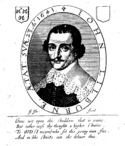
A year later, the trio of martyrs were joined by a fourth, John Lilburne, who had studied under John Bastwick. Since 1632, it had been illegal to publish or import works of literature not licensed by the Stationers' Company (which basically allowed the government the ability to view and censor any work prior to publication). Over the course of the 1630s, it became common for Puritans to have their works published in Amsterdam and then smuggled into England. In 1638, Lilburne was prosecuted in Star Chamber for importing religious works critical of Laudianism from Amsterdam. Lilburne thus began a process which would see him later hailed as "Freeborn John" and as the preeminent champion of "English liberties". In Star Chamber, he refused to plead to the charges against him on the grounds that the charges had been presented to him only in Latin. The court then threw him in prison and again brought him back to court and demanded a plea. Again, Lilburne demanded to hear in English the charges brought against him. The authorities then resorted to flogging him with a three-thonged whip on his bare back, as he was dragged by his hands tied to the rear of an oxcart from Fleet Prison to the pillory at Westminster. He was then forced to stoop in the pillory where he still managed to campaign against his censors, while distributing more unlicensed literature to the crowds. He was then gagged. Finally he was thrown in prison. He was taken back to the court and again imprisoned.
Suppression of the Feoffees for Impropriations
Beginning in 1625, a group of Puritan lawyers, merchants, and clergymen (including Richard Sibbes and John Davenport) organized an organization known as the Feoffees for the Purchase of Impropriations. The feoffees would raise funds to purchase lay impropriations and advowsons, which would mean that the feoffees would then have the legal right to appoint their chosen candidates to benefices and lectureships. Thus, this provided a mechanism both for increasing the number of preaching ministers in the country, and a way to ensure that Puritans could receive ecclesiastical appointments.
In 1630, Peter Heylin, a Magdalen don, preached a sermon in St Mary's denouncing the Feoffees for Impropriations for sowing tares among the wheat. As a result of the publicity, William Noy began to prosecute feoffees in the Exchequer court. The feoffees' defense was that all of the men they had had appointed to office conformed to the Church of England. Nevertheless in 1632, the Feoffees for Impropriations were dissolved and the group's assets forfeited to the crown: Charles ordered that the money should be used to augment the salary of incumbents and used for other pious uses not controlled by the Puritans.
The Bishops' Wars, 1638-1640
As noted above, James had tried to bring the English and Scottish churches closer together. In the process, he had restored bishops to the Church of Scotland and forced the Five Articles of Perth on the Scottish church, moves which upset Scottish Presbyterians. Charles now further angered the Presbyterians by elevating the bishops' role in Scotland even higher than his father had, to the point where in 1635, the Archbishop of St Andrews, John Spottiswoode, was made Lord Chancellor of Scotland. Presbyterian opposition to Charles reached a new height of intensity in 1637, when Charles attempted to impose a version of the Book of Common Prayer on the Church of Scotland. Although this book was drawn up by a panel of Scottish bishops, it was widely seen as an English import and denounced as Laud's Liturgy. What was worse, where the Scottish prayer book differed from the English, it seemed to be re-introducing old errors which had not yet been re-introduced in England. As a result, when the newly-appointed Bishop of Edinburgh, David Lindsay, rose to read the new liturgy in St. Giles' Cathedral, Jenny Geddes, a member of the congregation, threw her stool at Lindsay, thus setting off the Prayer Book Riot.
The Scottish prayer book was deeply unpopular with Scottish noblemen and gentry, not only on religious grounds, but also for nationalist reasons: Knox's Book of Common Order had been adopted as the liturgy of the national church by the Parliament of Scotland, whereas the Scottish parliament was not consulted in 1637 and the new prayer book imposed solely on the basis of Charles' alleged royal supremacy in the church, a doctrine which had never been accepted by either the Church or Parliament of Scotland. A number of leading noblemen drew up a document known as the National Covenant in February 1638. Those who subscribed to the National Covenant are known as Covenanters. Later that year, the General Assembly of the Church of Scotland ejected the bishops from the church.
In response to this challenge to his authority, Charles raised an army and marched on Scotland in the "First Bishops' War" (1639). The English Puritans - who had a longstanding opposition to the bishops (which had reached new heights in the wake of the Prynne, Burton, Bastwick, and Lilburne cases) - were deeply dismayed that the king was now waging a war to maintain the office of bishop. The First Bishops' War ended in a stalemate, since both sides lacked sufficient resources to defeat their opponents (in Charles' case, this was because he did not have enough revenues to wage a war since he had not called a Parliament since 1629), which led to the signing of the Treaty of Berwick (1639).
Charles intended to break the Treaty of Berwick at the next opportunity, and upon returning to London, began preparations for calling a Parliament that could pass new taxes to fund a war against the Scots and to re-establish episcopacy in Scotland. This Parliament - known as the Short Parliament because it only lasted three weeks - met in 1640. Unfortunately for Charles, many Puritan members were elected to the Parliament, and two critics of royal policies, John Pym and John Hampden, emerged as loud critics of the king in the Parliament. These members insisted that Parliament had an ancient right to demand the redress of grievances and insisted that the nation's grievances with the past ten years of royal policies should be dealt with before Parliament granted Charles the taxes that he wanted. Frustrated, Charles dissolved Parliament three weeks after it opened.
In Scotland, the rebellious spirit continued to grow in strength. Following the signing of the Treaty of Berwick, the General Assembly of Scotland met in Edinburgh and confirmed the abolition of episcopacy in Scotland, and then went even further and declared that all episcopacy was contrary to the Word of God. When the Scottish Parliament met later in the year, it confirmed the Church of Scotland's position. The Scottish Covenanters now determined that Presbyterianism could never be confidently re-established in Scotland so long as episcopacy remained the order of the day in England. They therefore determined to invade England to help bring about the abolition of episcopacy. At the same time, the Scots (who had many contacts among the English Puritans) learned that the king was intending to break the Treaty of Berwick and make a second attempt at invading Scotland. When the Short Parliament was dissolved without having granted Charles the money he requested, the Covenanters determined that the time was ripe to launch a preemptive strike against English invasion. As such, in August 1640, the Scottish troops marched into northern England, beginning the "Second Bishops' War". Catching the king unawares, the Scots gained a major victory at the Battle of Newburn. The Scottish Covenanters thus occupied the northern counties of England and imposed a large fine of £850 a day on the king until a treaty could be signed. Believing that the king was not trustworthy, the Scottish insisted that the Parliament of England be a part of any peace negotiations. Bankrupted by the Second Bishops' War, Charles had little choice but to call a Parliament to grant new taxes to pay off the Scots. He therefore reluctantly called a Parliament which would not be finally dissolved until 1660, the Long Parliament.
The Canons of 1640 and the Et Cetera Oath
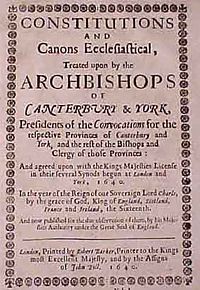
The Convocation of the English Clergy traditionally met whenever Parliament met, and was then dissolved whenever Parliament was dissolved. In 1640, however, Charles ordered Convocation to continue sitting even after he dissolved the Short Parliament because the Convocation had not yet passed the canons which Charles had had Archbishop Laud draw up and which confirmed the Laudian church policies as the official policies of the Church of England. Convocation dutifully passed these canons in late May 1640.
The preamble to the canons claims that the canons are not innovating in the church, but are rather restoring ceremonies from the time of Edward VI and Elizabeth I which had fallen into disuse. The first canon asserted that the king ruled by divine right; that the doctrine of Royal Supremacy was required by divine law; and that taxes were due to the king "by the law of God, nature, and nations." This canon led many MPs to conclude that Charles and the Laudian clergy were attempting to use the Church of England as a way to establish an absolute monarchy in England, and felt that this represented unwarranted clerical interference in the recent dispute between Parliament and the king over ship money.
Canons against popery and Socinianism were uncontroversial, but the canon against the sectaries was quite controversial because it was clearly aimed squarely at the Puritans. This canon condemned anyone who did not regularly attend service in their parish church or who attended only the sermon, not the full Prayer Book service. It went on to condemn anyone who wrote books critical of the discipline and government of the Church of England.
Finally, and most controversially, the Canons imposed an oath, known to history as the Et Cetera Oath, to be taken by every clergyman, every Master of Arts not the son of a nobleman, all who had taken a degree in divinity, law, or physic, all registrars of the Consistory Court and Chancery Court, all actuaries, proctors and schoolmasters, all persons incorporated from foreign universities, and all candidates for ordination. The oath read
| “ | I, A. B., do swear that I do approve the doctrine, and discipline, or government established in the Church of England as containing all things necessary to salvation: and that I will not endeavour by myself or any other, directly or indirectly, to bring in any popish doctrine contrary to that which is so established; nor will I ever give my consent to alter the government of this Church by archbishops, bishops, deans, and archdeacons, &c., as it stands now established, and as by right it ought to stand, nor yet ever to subject it to the usurpations and superstitions of the see of Rome. And all these things I do plainly and sincerely acknowledge and swear, according to the plain and common sense and understanding of the same words, without any equivocation, or mental evasion, or secret reservation whatsoever. And this I do heartily, willingly, and truly, upon the faith of a Christian. So help me God in Jesus Christ. | ” |
The Puritans were furious. They attacked the Canons of 1640 as unconstitutional, claiming that Convocation was no longer legally in session after Parliament was dissolved. The campaign to enforce the Et Cetera Oath met with firm Puritan resistance, organized in London by Cornelius Burges, Edmund Calamy the Elder, and John Goodwin. The imposition of the Et Cetera Oath also resulted in the Puritans' pro-Scottish sympathies becoming even more widespread, and there were rumours - possible but never proven - that Puritan leaders were in treasonable communication with the Scottish during this period. Many Puritans refused to read the prayer for victory against the Scottish which they had been ordered to read.
The Long Parliament attacks Laudianism and considers the Root and Branch Petition, 1640-42
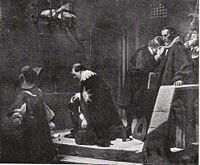
The elections to the Long Parliament in November 1640 produced a Parliament which was even more dominated by Puritans than the Short Parliament had been. Parliament's first order of business was therefore to move against Thomas Wentworth, 1st Earl of Strafford, who had served as Charles' Lord Deputy of Ireland since 1632. In the wake of the Second Bishops' War, Strafford had been raising an Irish Catholic army in Ireland which could be deployed against the Scottish Covenanters. Puritans were appalled that an army of Irish Catholics (whom they hated) would be deployed by the crown against the Scottish Presbyterians (whom they loved), and many English Protestants who were not particularly puritanical shared the sentiment. Having learned that Parliament intended to impeach him, Strafford presented the king with evidence of treasonable communications between Puritans in Parliament and the Scottish Covenanters. Nevertheless, through deft political manoeuvering, John Pym, along with Oliver St John and Lord Saye, managed to quickly have Parliament impeach Strafford on charges of high treason and Strafford was arrested. At his trial before the House of Lords, begun in January 1641, prosecutors argued that Strafford intended to use the Irish Catholic army against English Protestants. Strafford responded that the army was intended to be used against the rebellious Scots. Strafford was ultimately acquitted in April 1641 on the grounds that his actions did not amount to high treason. As a result, Puritan opponents of Strafford launched a bill of attainder against Strafford in the House of Commons; in the wake of a revolt by the army, which had not been paid in months, the House of Lords also passed the bill of attainder, and Charles, worried that the army would revolt further if they were not paid, and that the army would never be paid until Parliament granted funds, and that Parliament would not grant funds without Strafford's death, signed the bill of attainder in May 1641. Strafford was executed before a crowd of 200,000 on May 12, 1641.
The Puritans took advantage of the mood of the Parliament and of the public and organized the Root and Branch Petition, so called because it called for the abolition of episcopacy "root and branch". The Root and Branch Petition was signed by 15,000 Londoners and presented to Parliament by a crowd of 1,500 on December 11, 1640. The Root and Branch Petition detailed many of the Puritans' grievances with Charles and the bishops. It complained that the bishops had silenced many godly ministers and made ministers afraid to instruct the people about "the doctrine of predestination, of free grace, of perseverance, of original sin remaining after baptism, of the sabbath, the doctrine against universal grace, election for faith foreseen, freewill against Antichrist, non-residents (ministers who did not live in their parishes), human inventions in God's worship". The Petition condemned the practice of bestowing temporal power on bishops and the encouraging of ministers to disregard the temporal authority. The Petition condemned the regime for suppressing godly books while allowing the publication of popish, Arminian, and lewd books (such as Ovid's Ars Amatoria and the ballads of Martin Parker). The Petition also hit on several of the Puritans' routine complaints: the Book of Sports, the placing of communion tables altar-wise, the church beautification scheme, the imposing of oaths, the influence of Catholics and Arminians at court, and the abuse of excommunication by the bishops.
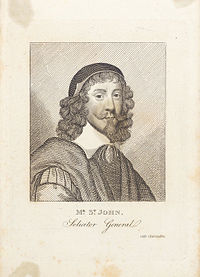
In December 1640, the month after it impeached Strafford, Parliament had also impeached Archbishop Laud on charges of high treason. He was accused of subverting true religion, assuming pope-like powers, attempting to reconcile the Church of England with the Roman Catholic Church, of persecuting godly preachers, of ruining the Church of England's relations with the Reformed churches on the Continent, of promoting the war with Scotland, and with a variety of other offenses. During this debate, Harbottle Grimston famously called Laud "the roote and ground of all our miseries and calamities … the sty of all pestilential filth that hath infected the State and Government." Unlike Strafford, however, Laud's enemies did not move quickly to secure his execution, and he was imprisoned in the Tower of London in February 1641.
In March 1641, the House of Commons passed the Bishops Exclusion Bill, which would have prevented the bishops from taking their seats in the House of Lords. The House of Lords, however, rejected this bill.
In May 1641, Henry Vane the Younger and Oliver Cromwell introduced the Root and Branch Bill, which had been drafted by Oliver St John and which was designed to root out episcopacy in England "root and branch" along the lines advocated in the Root and Branch Petition. Many moderate MPs, such as Lucius Cary, 2nd Viscount Falkland and Edward Hyde, were dismayed: although they believed that Charles and Laud had gone too far in the 1630s, they were not prepared to abolish episcopacy. The debate over the Root and Branch Bill was intense - the Bill was finally rejected in August 1641. The division of MPs over this bill would form the basic division of MPs in the subsequent war, with those who favoured the Root and Branch Bill becoming Roundheads and those who defended the bishops becoming Cavaliers.
Unsurprisingly the debate surrounding the Root and Branch Bill occasioned a lively pamphlet controversy. Joseph Hall, the Bishop of Exeter, wrote a spirited defense of episcopacy entitled An Humble Remonstrance to the High Court of Parliament. This drew forth a response from five Puritan authors, who wrote under the name Smectymnuus, an acronym based on the their names ( Stephen Marshall, Edmund Calamy, Thomas Young, Matthew Newcomen, and William Spurstow). Smectymnuus's first pamphlet, An Answer to a booke entituled, An Humble Remonstrance. In Which, the Original of Liturgy and Episcopacy is Discussed, was published in March 1641. It is believed that one of Thomas Young's former students, John Milton, wrote the postscript to the reply. (Milton published several anti-episcopal pamphlets in 1640-41). A prolonged series of answers and counter-answers followed.
Worried that the king would again quickly dissolve Parliament without redressing the nation's grievances, John Pym pushed through an Act against Dissolving Parliament without its own Consent; desperately in need of money, Charles had little choice but to consent to the Act. The Long Parliament then sought to undo the more unpopular aspects of the past eleven years. Star Chamber, which had been used to silence Puritan laymen, was abolished in July 1641. The Court of High Commission was also abolished at this time. Parliament ordered Prynne, Burton, Bastwick, and Lilburne released from prison, and they returned to London in triumph.
In October 1641, Irish Catholic gentry launched the Irish Rebellion of 1641, throwing off English domination and creating Confederate Ireland. English parliamentarians were terrified that an Irish army might rise to massacre English Protestants. In this atmosphere, in November 1641, Parliament passed the Grand Remonstrance, detailing over 200 points which Parliament felt that the king had acted illegally in the course of the Personal Rule. The Grand Remonstrance marked a second moment at which a number of the more moderate, non-Puritan members of Parliament (e.g. Viscount Falkland and Edward Hyde) felt that Parliament had gone too far in its denunciations of the king and was showing too much sympathy for the rebellious Scots.
When the bishops attempted to take their seats in the House of Lords in late 1641, a pro-Puritan, anti-episcopal mob, probably organized by John Pym prevented them from doing so. The Bishops Exclusion Bill was re-introduced in December 1641, and this time, the mood of the country was such that neither the House of Lords nor Charles felt strong enough to reject the bill. The Bishops Exclusion Act prevented those in holy orders from exercising any temporal jurisdiction or authority after February 5, 1642; this extended to taking a seat in Parliament or membership of the Privy Council. Any acts carried out with such authority after that date by a member of the clergy were to be considered void.
In this period, Charles became increasingly convinced that a number of Puritan-influenced members of Parliament had treasonously encouraged the Scottish Covenanters to invade England in 1640, leading to the Second Bishops' War. As such, when he heard that they were planning to impeach the Queen for participation in Catholic plots, he determined to arrest Lord Mandeville as well as five MPs, known to history as the Five Members: John Pym, John Hampden, Denzil Holles, Sir Arthur Haselrig, and William Strode. Charles famously entered the House of Commons personally on January 4, 1642, but the members had already fled.
Following his failed attempt to arrest the Five Members, Charles realized that he was not only immensely unpopular among parliamentarians, he was also in danger of London's pro-Puritan, anti-episcopal, and increasingly anti-royal mob. As such, he and his family retreated to Oxford and invited all loyal parliamentarians to join him. He began raising an army under George Goring, Lord Goring.
Puritans in Parliament were now in a sticky situation: on the one hand, they wanted to raise an army to defend England against the Irish Catholics who were rebelling; on the other hand, they were worried that the king could not be trusted and that if he were given control of the army, he would use it against the Scots, not the Irish. To avoid this problem, Parliament began appointing Lord Lieutenants, a function traditionally done only by the king. Then, Parliament passed a Militia Ordinance which raised a militia, but provided that the militia should be controlled by Parliament. The king, of course, refused to sign this bill. A major split between Parliament and the king occurred on March 15, 1642, when Parliament declared that "the People are bound by the Ordinance for the Militia, though it has not received the Royal Assent", the first time a Parliament had declared its acts to operate without receiving royal assent. Under these circumstances, the political nation began to divide itself into Roundheads and Cavaliers. The first clash between the royalists and the parliamentarians came in the April 1642 Siege of Hull, which began when the military governor appointed by Parliament, Sir John Hotham refused to allow Charles' forces access to military material in Kingston upon Hull. In August, the king officially raised his standard at Nottingham and the First English Civil War was underway.
The Westminster Assembly, 1643-49
In 1642, the most ardent defenders of episcopacy in the Long Parliament left to join King Charles on the battlefield. However, although Civil War was beginning, Parliament was initially reluctant to pass legislation without it receiving royal assent. Thus, between June 1642 and May 1643, Parliament passed legislation providing for a religious assembly five times, but these bills did not receive royal assent and thus died. By June 1643, however, Parliament was willing to defy the king and call a religious assembly without the king's assent. This assembly, the Westminster Assembly, had its first meeting in the Henry VII Lady Chapel of Westminster Abbey on July 1, 1643. (In later sessions, the Assembly would meet in the Jerusalem Chamber.)
The Assembly was charged with drawing up a new liturgy to replace the Book of Common Prayer and with determining what manner of church polity was appropriate for the Church of England. In both cases, it was assumed that the Westminster Assembly would only make recommendations and that Parliament would have the final word.
The Long Parliament appointed 121 divines to the Westminster Assembly (at the time "divine" was a synonym for " clergyman"). Of these, approximately 25 never showed up - mainly because King Charles ordered all loyal subjects not to participate in the Assembly. To replace the divines who had failed to show up, Parliament later added 21 additional divines, known as the "Superadded Divines". The Assembly also included 30 lay assessors (10 nobles and 20 commoners). Although the Westminster Divines were mainly Puritan, they were broadly representative of all positions (except Laudianism) then on offer in the Church of England.

For its first ten weeks, the Westminster Assembly's only task was to revise the Thirty-Nine Articles. However, in summer 1643, shortly after the calling of the Westminster Assembly, the Parliamentary forces, under the leadership of John Pym and Henry Vane the Younger concluded an agreement with the Scots known as the Solemn League and Covenant. As noted above, one of the main reasons why the Scots had launched the Second Bishops War in 1640 was because they hoped to bring about an end to episcopacy in England. They therefore insisted as a term of the agreement that the English agree to fight to extirpate " popery and prelacy". Since the Puritans were also interested in fighting these things, they readily agreed, and the Long Parliament agreed to swear to the Scottish National Covenant. Six Commissioners representing the Church of Scotland were now sent to attend the Westminster Assembly and on October 12, 1643, the Long Parliament ordered the Assembly to "confer and treat among themselves of such a discipline and government as may be most agreeable to God's holy word, and most apt to procure and preserve the peace of the church at home, and nearer agreement with the Church of Scotland and other Reformed Churches abroad."
Parties at the Westminster Assembly
The Westminster Assembly's discussions on church polity mark a definitive turning point in Puritan history. Whereas Puritans had hitherto been united in their opposition to royal and episcopal ecclesiastical policies, they now became divided over the form that reforms to the Church of England should take. The Westminster Divines divided into four groups:
- The Episcopalians, who supported a moderate form of episcopal polity and who were led by James Ussher, Archbishop of Armagh;
- The Presbyterians, who favoured presbyterian polity - this position was pushed hard by the Scottish Commissioners, especially George Gillespie and Samuel Rutherford, while the most influential Englishman taking this position was probably Edward Reynolds;
- The Independents, who favoured congregationalist polity and who were led by Thomas Goodwin; and
- The Erastians, who believed that ecclesiastical polity was adiaphora, a matter indifferent, which ought to be determined by the state, and who were led by John Lightfoot.
Many issues divided the groups from each other:
- Was the matter of ecclesiastical polity jure divino (established by divine law) or adiaphora (a matter indifferent, with each national church free to establish its own polity)? The Erastians were the most vocal party in arguing that polity was not fixed by divine law, while the other groups were more likely to believe that their positions were dictated by the Scriptures.
- What amount of hierarchy was proper in the church? The Episcopalians believed that the church should be hierarchically organized, with the bishops providing a supervisory role over other clergy. The Presbyterians believed that the church should be organized hierarchically only in the sense that the church should be governed by a series of hierarchically-ordered assemblies ( Sessions, Presbyteries, Synods, and at the top the General Assembly). While the Presbyterian scheme involved hierarchical ordering in the church, its proponents stressed that it did not involve a hierarchical ordering among individuals in the church, since at each level, the governing body represented the church as a whole. The Independents opposed all forms of hierarchy in the church and argued that ministers should be accountable only to their own local congregations.
- What was the proper relationship of church and state? All parties at the Westminster Assembly rejected what was held to be the "papist" position, that church and state should be unified, but with the state subordinate to the church. The Erastians and many of the Episcopalian party maintained that church and state should be unified, but with the church subordinate to the state, a position traditionally known as caesaropapism (and expressed, for example, in the doctrine of the royal supremacy). The Presbyterians argued for complete separation of church and state, but nevertheless felt that the state should enforce religious uniformity in the country. The Independents went furthest of all, arguing that there should be not only separation of church and state, but also religious liberty.
- How uniform should the church's liturgy be? Those inclined to episcopalianism were most inclined to favour a liturgy similar to the Book of Common Prayer, just revised to make it doctrinally acceptable to Calvinists, but still containing set forms of prayers that would be used uniformly throughout the country. Those inclined to presbyterianism were more likely to favour something akin to Knox's Book of Discipline, which set out the general form of worship, but which left individual ministers free to compose their own prayers, and even to offer extemporaneous prayer. The Independents were more likely to oppose all set forms of worship, were okay with local variation in the form of worship, and felt that almost all prayer should be extemporaneous, offered spontaneously by the minister as he was moved by the Holy Spirit at the time of service.
The Independents Controversy, 1644
Even after the Royalists failed to turn up for the Westminster Assembly, the Episcopalians were probably in the majority or at least the plurality. However, the Episcopalian members of the Assembly proved less than zealous in their defense of episcopacy: when the Assembly scheduled debates and votes for the late afternoon and early evening, the Episcopalian members failed to attend, allowing the Presbyterians and Independents to dominate the Assembly's debates. In a famous bon mot, Lord Falkland observed that "those that hated the bishops hated them worse than the devil and those that loved them loved them not so well as their dinner."
Upon their arrival, the Scottish Commissioners - Alexander Henderson, George Gillespie, Samuel Rutherford, and Robert Baillie - organized a campaign to have the Church of England adopt a presbyterian system similar to the Church of Scotland. It initially appeared that the Scottish Commissioners might be able to push through their presbyterian scheme with only minimal resistance.
However, in February 1644, five members of the Assembly - known to history as the Five Dissenting Brethren - published a pamphlet entitled "An Apologetical Narration, humbly submitted to the Honorable Houses of Parliament, by Thomas Goodwin, Philip Nye, Sidrach Simpson, Jeremiah Burroughs, & William Bridge." This publication laid out the case for the Independent position forcefully, and made it impossible for the Scottish Commissioners to succeed in quickly creating an amicable consensus around the presbyterian position. Instead, in 1644, the Westminster Assembly became the sight of a series of heated debate between the Presbyterians and the Independents.
The Independents were the party most committed to experimental predestinariaism, the position that one can have assurance of election in this life. Experimental predestinarians tended to undergo dramatic conversion experiences. With the rise of experimental predestinarianism, there was a concomitant call among some of the godly for gathered churches. Unlike the Church of England - which theoretically encompassed everybody in England - a gathered church was made up only of those who had undergone a conversion experience. Following the suppression of Separatism in the late Elizabethan period, calls for gathered churches could only be whispered about. However, the social process of separating "the godly" from the rest of the congregation continued throughout the early seventeenth century. When the Puritans in New England set up their own congregations, in order to be admitted to the church, one had to be examined by the elders of the church, and then make a public profession of faith before the assembled congregation before being admitted to membership. The Independents supported the New England way and argued for its adoption in England. The result would be a situation where not all English people would be members of the church, but only those who had undergone a conversion experience and made a public confession of faith. Under these circumstances, one of the major reasons why the Independents favored congregational polity was that they argued that only other godly members of the congregation could identify who else was elect. The Independents condemned the suppression of the Separatists - why should the state be used to suppress the godly? They accused the Presbyterian party of wanting to continued the barbarous, "popish" persecutions of the Laudian bishops. For the first time, the Independents began to advocate a theory of religious liberty. Since they saw only a small minority of the community as actually "saved", they argued that it made no sense to have a uniform national church. Rather, each gathered church should be free to organize itself as it saw fit. They were therefore opposed not only to the Book of Common Prayer, but also to any attempt to reform the liturgy - they argued that in fact there shouldn't be any national liturgy at all, but that each minister and each congregation should be free to worship God in the way they saw fit.
The Presbyterians responded that the Independents were engaged in faction. The Presbyterians were Calvinists just like the Independents, but they spoke of predestination in a different way than the Independents. Some argued that England was an elect nation, that divine providence had chosen England as a special called nation, just as he had chosen the Israelites to be a chosen people in the Old Testament. Others argued that, while it is true that God has chosen some as elect and some as reprobate, it is really impossible in this life for any individual to know whether he or she was among the elect, and that life should therefore simply be lived in as close of conformity to the will of God as possible. They certainly did not approve of the Independents who thought that they were the only members of the elect in England: true, many members of the Church of England may have engaged in many open and notorious sins, but for the Presbyterians, that was a sign that the state needed to step in to punish those sins, lest God visit punishments on the nation in the same way that He visited punishments on Old Testament Israel when He found them sinning.
The Independent position was clearly in the minority at the Westminster Assembly - there were, after all, only Five Dissenting Brethren in an Assembly of roughly 120 divines - making it impossible for the Independents in the Assembly to get their position passed.
The Erastian Controversy, 1645-46
During the next two years, a second controversy occupied a great deal of time and attention of the Westminster Assembly: the controversy over Erastianism. The issue of the proper relationship of church and state - which was a part of the Independents Controversy - was at the heart of the Erastian Controversy.
During the Elizabethan Religious Settlement, two great Acts of Parliament had established the place of the Church of England in English life (1) the Act of Supremacy, which declared the monarch to be the Supreme Governor of the Church of England and which imposed an oath on all subjects requiring them to swear that they recognized the royal supremacy in the church; and (2) the Act of Uniformity, which established religious uniformity throughout the country by requiring all churches to conduct services according to the Book of Common Prayer.
The events of the 1640s caused the English legal community to worry that the Westminster Assembly was preparing to illegally alter the church in a way that overrode the Act of Supremacy. As such, John Selden, arguably the foremost jurist in England since the death of Edward Coke in 1634, led a campaign against altering the Church of England in a way that would undermine the Act of Supremacy. Thus, just as the Presbyterian party in the Assembly was dominated by non-members (the Scottish Commissioners), the Erastian party was dominated by Selden and the other lawyers. Selden argued that not only English law, but the Bible itself required that the church be subordinate to the state: he cited the relationship of Zadok to King David and Romans 13 in support of this view.
Beginning in April 1645, the Assembly shifted its attention from the Independents Controversy to the Erastian Controversy. Besides John Lightfoot, the most zealous proponent of the Erastian position was Bulstrode Whitelocke, one of the MPs serving as a lay assessor to the Assembly. Whitelock maintained that only the state - and not the church - could lawfully exercise the power of excommunication.
In October 1645, the Scottish Commissioners got their way when the Long Parliament voted in favour of an ordinance erecting a presbyterian form of church government in England. However, they were appalled that the Parliament also adopted the Erastian argument and made any final decision of the church on the question of excommunication appealable from the General Assembly to the Parliament of England.
This decision provoked protests from the Presbyterian party. The Parliament of Scotland, worried that the Long Parliament was failing to live up to its commitments under the Solemn League and Covenant, protested the Erastian nature of the ordinance. The ministers of London organized a petition to the Parliament. The Westminster Assembly responded by sending a delegation, led by Stephen Marshall, a fiery preacher who had delivered several sermons to the Long Parliament, to protest the Erastian nature of the ordinance. (Some MPs argued that the Assembly by this action committed a praemunire and should be punished.) Parliament responded by sending a delegation which included Nathaniel Fiennes to the Westminster Assembly, along with a list of interrogatories related to the jure divino nature of church government. The Assembly responded by flatly rejecting the Erastian position - with John Lightfoot and Thomas Coleman being the lone members speaking in favour of Erastianism.
The Presbyterian party now initiated a massive public relations campaign and it was during 1646 that many of the major defenses of Presbyterianism were published, beginning with Jus Divinum Regiminis Ecclesiastici ; or, The Divine Right of Church Government Asserted and Evidenced by the Holy Scriptures. By sundry Ministers of Christ within the City of London, published in December 1646. One of the Scottish Commissioners, Samuel Rutherford, published a book entitled The Divine Right of Church Government and Excommunication. A second Scottish Commissioner, George Gillespie engaged in a pamphlet debate with Coleman: in response to a sermon which Coleman published advocating the Erastian position, Gillespie published A Brotherly Examination of some Passages of Mr. Coleman’s late printed Sermon; Coleman responded with A Brotherly Examination Re-examined; Gillespie responded with Nihil Respondes; Coleman replied with Male Dicis Maledicis; and Gillespie responded with Male Audis. Gillespie also had words for William Prynne, who had written in favour of the Parliament's ordinance; Prynne was a special target of attack when Gillespie produced his magnum opus, Aaron’s Rod Blossoming; or, The Divine Ordinance of Church Government Vindicated, a work which partially incorporated material from the controversy with Coleman.
The Presbyterian party also used their strength in London to petition the Parliament in favour of their position.
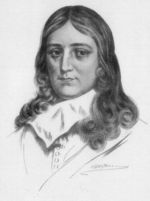
Although in August 1645, Parliament had passed an ordinance expressing its intent to set up elders throughout the country, it had not actually provided how this should be done. On March 14, 1646, Parliament passed the "Ordinance for keeping scandalous persons from the Sacrament of the Lord's Supper, for the choice of elders, and for supplying defects in former Ordinances concerning church government." This Ordinance provided mechanisms for selecting elders throughout the country, and generally established a Presbyterian system of church governance for the country. However, this Ordinance again contained an Erastian element. The Ordinance created a new office of "commissioners to judge of scandalous offenses": these commissioners were granted jurisdiction to determine if a "scandalous offense" warranted excommunication and sessions were forbidden from excommunicating any church member without a commissioner first having signed off on the excommunication. The Presbyterian party was furious at the inclusion of the office of commissioner in the act that created Presbyterian polity in England.
The Independent party was angry that Parliament remained in the business of enforcing religious conformity at all. The most famous expression of the Independents' despondency at the Long Parliament's actions was John Milton's poem " On the New Forcers of Conscience under the Long Parliament". Milton argued that the Long Parliament was imitating popish tyranny in the church; violating the biblical principle of Christian liberty; and engaging in a course of action that would punish godly men. He concluded the poem with the famous line, "New Presbyter is but old Priest writ large" (a play on words since in English, the word "Priest" emerged as a contraction of the Greek word "Presbyter", but also claiming that the Presbyters under the Long Parliament's plan would be even worse than the Catholic and Laudian priests whom all Puritans abhorred).
The Creation of the Westminster Standards, 1641-1646
At the same time that the Westminster Assembly had been debating ecclesiology, they had also been reviewing worship and doctrine. These aspects generated less controversy amongst the divines.
Tasked with reforming the English liturgy, the Assembly first considered simply adopting John Knox's Book of Common Order, but this possibility was rejected by the Assembly in 1644, and the work of drawing up a new liturgy entrusted to a committee. This committee drafted the Directory of Public Worship, which was passed by the Westminster Assembly in 1645. Unlike the Book of Common Prayer, which had contained detailed rubrics regulating in minute detail how clergymen were supposed to conduct service, the Directory of Public Worship is basically a loose agenda for worship, and expected the minister to fill in the details. Under the Directory, the focus of the service was on preaching. The service opened with a reading of a passage from the Bible; followed by an opening prayer (selected or composed by the minister, or offered extemporaneously by the minister); followed by a sermon; and then ended with a closing prayer. The Directory provides guidelines as to what the prayers and sermon ought to contain, but does not contain any set forms of prayers. The Directory encouraged the public singing of psalms, but left it to the minister's discretion which psalms should be used in the service and where in the service (contrast this with the Book of Common Prayer, which set out the precise order for singing psalms for every day of the year in a way that ensured that the entire Book of Psalms is sung once a month). The sections dealing with baptism, communion, marriage, funerals, days of public fasting and days of public thanksgiving all have a similar character.
In 1643, the Long Parliament had ordered the Westminster Assembly to draw up a new Confession of Faith and a new national catechism. The result was the production of the Westminster Confession of Faith and two catechisms, the Westminster Larger Catechism (designed to be comprehensive) and the Westminster Shorter Catechism (designed to be easier for children to memorize).
The Long Parliament approved the Directory of Public Worship in 1645. The Westminster Confession was presented to Parliament in 1646, but the House of Commons returned the Confession to the Assembly with the instruction that proof texts from Scripture should be added to the Confession. This version was resubmitted to Parliament in 1648, and, after a long a rigorous debate (during the course of which some chapters and sections approved by the Assembly were deleted), the Confession was ratified by the Long Parliament. The Larger Catechism was completed in 1647, and the Shorter Catechism in 1648, and both received the approval of both the Westminster Assembly and the Long Parliament.
Since the Westminster Standards had been produced under the watchful eye of the Scottish Commissioners at the Westminster Assembly, the Scottish had no problem ratifying the Westminster Standards in order to keep Scotland's commitment to England under the Solemn League and Covenant. Since the Directory set up a type of ecclesiology already practiced in the Church of Scotland, it was quickly ratified by the General Assembly of the Church of Scotland and then by the Parliament of Scotland in 1646. The Larger and Shorter Catechisms were ratified by General Assembly in 1648 and the Westminster Confession in 1649. The Westminster Standards are the general standards of the Church of Scotland and of nearly all Presbyterian denominations to this day.
Its work being completed, the Westminster Assembly was dissolved in 1649.
Oliver Cromwell and the Independent ascendancy in the New Model Army
In 1646, the Presbyterian party committed themselves to a fateful course of action. As background, we need to briefly consider the course of the First English Civil War.
Parliamentary forces had initially fared poorly against royalist forces: the first major battle of the war, the Battle of Edgehill on October 23, 1642, was inconclusive, as was the First Battle of Newbury of September 20, 1643. As noted above, as a result of their failure to defeat the king on the battlefield, in the wake of the First Battle of Newbury, the Long Parliament decided to enter into an alliance with the Scottish, which resulted in the Solemn League and Covenant (by which the Long Parliament agreed to establish presbyterianism in England), and with the war being entrusted to a joint committee of Scottish and English known as the Committee of Both Kingdoms. With the addition of the Scottish forces, the parliamentarians now won a decisive victory at the Battle of Marston Moor on July 2, 1644.

The most successful parliamentary cavalry commander had been Oliver Cromwell, and Cromwell now approached the Committee of Both Kingdoms with a proposal. Cromwell had come to the conclusion that the current military system was untenable because it relied on local militias defending local areas. Cromwell proposed that Parliament create a new army that would be deployable anywhere in the kingdom and not tied to a particular locality. After the Second Battle of Newbury of October 27, 1644, where parliamentary forces greatly outnumbered royalist forces and yet parliamentary forces were barely able to defeat the royalist forces, Cromwell redoubled his arguments in favour of creating a new army. At this point, most of the leaders in the parliamentary army were Presbyterians who supported the Presbyterians at the Westminster Assembly. Cromwell, however, had also been following the goings-on of the Westminster Assembly and he sided with the Independents. Cromwell thought that the Presbyterians in the army - notably his superior, Edward Montagu, 2nd Earl of Manchester - opposed his proposal to create a new and more effective army mainly because they wanted to make peace with the king. He also thought that the army's supreme commander, Robert Devereux, 3rd Earl of Essex, shared Manchester's views. Cromwell, however, felt that parliamentary forces should seek total victory over the royalists, and since he distrusted Charles immensely, he felt that Charles should have no role in any post-war government.
Cromwell, who was an MP as well as a military commander, now devised a brilliant way to out-maneuver his enemies in the army. In Parliament, Cromwell suddenly proposed a dramatic way to resolve his differences with Manchester and Essex. On December 9, 1644, Cromwell introduced a bill in Parliament saying that no member of either the House of Commons or the House of Lords could retain his position as a military commander while serving as a member of Parliament. Members would have to choose: either resign from Parliament or resign from the army. Cromwell's bill was passed by the House of Commons but rejected by the House of Lords in January 1645, who were worried that this would mean that no nobleman could serve as a commander in the army. To assuage this worry, Cromwell re-introduced his bill with a provision saying that, if Parliament wished, it could re-appoint any parliamentarian who resigned from the army to the army if it so chose. The Lords were ultimately persuaded by Cromwell, and on January 13, 1645 passed this bill, known to history as the Self-denying Ordinance. At roughly the same time, on January 6, 1645, the Committee of Both Kingdoms finally approved Cromwell's request and authorized the creation of the New Model Army. In the wake of the Self-denying Ordinance, Essex and Manchester both resigned from the army in order to retain their positions in the House of Lords. Cromwell, instead, resigned from the House of Commons rather than forfeit his position in the army. Thus, when the New Model Army was organized under Sir Thomas Fairfax, Cromwell was the most senior army commander left in the army. Fairfax therefore leaned on Cromwell as his number-two during the organization of the New Model Army. Cromwell did everything in his power to ensure that no Presbyterians were recruited to the New Model Army, and that Independents were encouraged to join the New Model Army. Cromwell had thus created a situation where the Presbyterians dominated the Long Parliament, but the Independents dominated the New Model Army.
At the Battle of Naseby on June 16, 1645, the New Model Army achieved a decisive victory over royalist forces. A number of subsequent battles were needed to finally defeat the royalist forces. In May 1646, Charles surrendered himself over to Scottish forces at Southwell, Nottinghamshire.
So, to summarize the situation as we move into 1647: On the one hand, you have the leaders of the Long Parliament and the Scottish favoring peace with Charles and a restoration of Charles to power as a constitutional monarch, while Oliver Cromwell, the Independent leader of the New Model Army, wants to get rid of Charles. On the other hand, you have the Scottish and the Presbyterian party at the Westminster Assembly pushing for a pure form of Presbyterian polity for the Church of England, while the Long Parliament has enacted a form of presbyterianism which contains Erastian elements which the Westminster Presbyterian party and the Scottish find deeply distasteful. Under these circumstances, the Scottish, and the Presbyterian party at the Westminster Assembly (a party which had been dominated by the Scottish Commissioners) decided to approach the king in order to seek his support against the Independents and the Erastians.
The Second English Civil War (1648-49) and the Regicide (1649)
In summer and fall 1647, Henry Ireton and John Lambert negotiated with both houses of parliament and eventually the Army and Parliament reached agreement on a set of proposals, known as the Heads of Proposals, which were presented to Charles in November 1647. The main propositions were
- Royalists had to wait five years before running for or holding an office.
- The Book of Common Prayer was allowed to be read but not mandatory, and no penalties should be made for not going to church, or attending other acts of worship.
- The sitting Parliament was to set a date for its own termination. Thereafter, biennial Parliaments were to be called (i.e. every two years), which would sit for a minimum of 120 days and maximum of 240 days. Constituencies were to be reorganized.
- Episcopacy would be retained in church government, but the power of the bishops would be substantially reduced.
- Parliament was to control the appointment of state officials and officers in the army and navy for 10 years.
Charles, however, rejected the Heads of Proposals.
Instead, Charles negotiated with a faction of Scottish Covenanters and on December 26, 1647, signed The Engagement, a secret treaty with the group of Scottish Covenanters who became known as the Engagers. Under the Engagement, Charles agreed that episcopacy should be suppressed in the Church of England, and he agreed to support presbyterianism for three years, after which a permanent solution to the question of the church's polity could be worked out. In exchange, the Engagers agreed to bring an army of 20,000 into England in order to suppress the New Model Army and restore Charles to his throne. This led to the Second English Civil War. Unfortunately for Charles and the Engagers (and the English Presbyterians), Charles' forces were defeated decisively at the Battle of Preston on August 17-19, 1648.
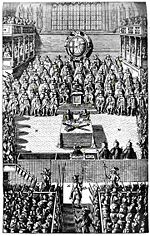
The Independents in the Army now argued that Charles was a "man of blood" who deserved to be punished. They argued that the outcome of the First English Civil War was proof of God's judgment against Charles. Taking up arms after that judgment had been rendered resulted in the shedding of innocent blood. The leaders of the army therefore drafted The Remonstrance of the Army in November 1648, calling on the Long Parliament to execute Charles and to replace hereditary monarchy in England with an elective monarchy. When the Long Parliament rejected the Army's Remonstrance, the Army leaders decided that they would take decisive action. Thus, on December 6, 1648, Colonel Thomas Pride led a coup d'état known as Pride's Purge - his forces entered the House of Commons and physically removed all MPs who opposed the Independent party from the Parliament.
After the Purge, the remaining parliament - known as the Rump Parliament - proceeded to do what the Long Parliament refused to do: put Charles on trial for high treason. The House of Commons passed an act on January 3, 1649 creating a High Court of Justice for the trial of Charles I. This Act was rejected by the House of Lords, but the Army insisted that the trial go ahead anyway. His trial began on January 20, 1649 in Westminster Hall and ended on January 27, 1649 with a guilty verdict. 59 Commissioners signed Charles' death warrant, and he was subsequently executed on January 30, 1649.
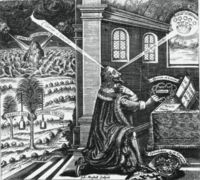
The execution of Charles I would be the lens through which the Puritan movement was viewed for generations. For opponents of Puritanism, this confirmed what they had been saying for years: that Puritanism ultimately led to violent rebellion and that there was a straight line from religious fanaticism to regicide. As we have seen, the Puritan movement grew increasingly fractured over the course of the 1640s. The largest group of Puritans, the Presbyterians, had in fact opposed the regicide, but to the supporters of the king and of episcopacy, this seemed like too fine a distinction. On the other hand, for many Independents, the regicide was entirely justified: Charles was a man who had been a tyrant and who defied the will of God and therefore had to be punished.
The most important literary exchange over the regicide occurred when royalists published Eikon Basilike immediately upon Charles' execution. Eikon Basilike purported to be written by Charles during his time in captivity, but was almost certainly ghost-written, likely by John Gauden. In this book, Charles is presented as a " devout son of the Church of England" who was unjustly hounded by Puritan persecutors and ultimately martyred for defending the Church of England against the Puritans' religious fanaticism. John Milton - who by now had emerged as the most important Independent polemicist - responded to the book later in 1649 in a book he entitled Eikonoklastes, which was a point-by-point response to Eikon Basilike's flattering portrait of Charles and its unflattering portrait of the Parliamentarians and the Army.
The English Interregnum, 1649-1660
The English Interregnum was a period of great religious diversity and experimentation in England. With the creation of the Commonwealth of England in 1649, government passed to the English Council of State, a group dominated by Oliver Cromwell, an advocate of religious liberty. In 1650, at Cromwell's behest, the Rump Parliament abolished the Act of Uniformity, meaning that while England now had an officially established church with Presbyterian polity, there was no legal requirement that anyone attend services in the established church.
As noted above, in 1646, the Long Parliament had abolished episcopacy in the Church of England and replaced it with a presbyterian system, and had voted to replace the Book of Common Prayer with the Directory of Worship. However, the actual implementation of these reforms in the church proceeded slowly for a number of reasons:
- In many localities - especially those areas which had been Royalist during the Civil Wars and which had low numbers of Puritans, both the bishops and the Book of Common Prayer were popular and local ministers as well as local congregations simply continued to conduct worship in their ordinary way.
- Independents opposed the scheme, so rather than try to implement the presbyterian scheme, they simply started conducting themselves as gathered churches.
- Clergymen who favored presbyterianism nevertheless disliked the Long Parliament's ordinance because it included an Erastian element in the office of "commissioner". They were thus less than enthusiastic about implementing the Long Parliament's scheme.
- Since the office of bishop had been abolished in the church, and the Long Parliament really hadn't provided a substitute, there was no one to enforce the new presbyterianism scheme on the church, so the combination of opposition and apathy meant that little was done.
The abolition of episcopacy meant that there was no longer a mechanism for enforcing religious uniformity in the country, and with the abolition of the Act of Uniformity, even the pretense of religious uniformity broke down. Thus, while the Presbyterians were dominant (at least theoretically) within the established church, those Puritans who opposed Presbyterianism were basically free to start conducting themselves in the way they wanted.
One of the things that happened at this point was that Separatists, who had previously organized themselves underground, were able to worship openly. For example, as early as 1616, the first English Baptists had organized themselves in secret, under the leadership of Henry Jacob, John Lothropp, and Henry Jessey. Now, however, they were less secretive. Other ministers - who favored the congregationalist New England Way - also began setting up their own congregations outside of the established church.
Many sects were also organized during this time. It is not clear that they should be called "Puritan" sects since they placed less emphasis on the Bible than is characteristic of Puritans, instead insisting on the role of direct contact with the Holy Spirit. These groups included the Ranters, the Fifth Monarchists, the Seekers, the Muggletonians, and - most prominently and most lastingly - the Quakers.
From 1660 to present day
The influence of the Puritan movement persisted in England in various forms. All official discrimination against Puritans in England ended in the 1640s when Puritan forces under Oliver Cromwell overthrew the monarchy in the English Civil War.
Great Ejection
With the restoration of the monarchy in 1660 the Church of England attempted to re-assert its authority as the official English church. In 1662, the "Great Ejection" followed the passage of the Act of Uniformity in England. Around two thousand Puritan ministers were forced to resign from their positions as Church of England clergy following the restoration of Charles II. Persecution of the Puritans then occurred sporadically under the terms of what later became known as The Clarendon Code (Gatiss, The Tragedy of 1662). Persecution from the state and the established church was somewhat abated under James II and then after the Glorious Revolution under William and Mary.
Later trends
Puritan experience also motivated the later Latitudinarian and Evangelical trends in the Church of England. Meanwhile, in Europe, in the 17th and 18th centuries, a movement within Lutheranism based on puritan ideology became a strong religious force known as pietism. In the USA, the Puritan settlement of New England was a major influence on American Protestantism.
With the start of the English Civil War in the 1640s, fewer and fewer immigrants to New England were Puritans. Very few immigrants to Virginia and other early colonies were Puritans. Most immigrants to Virginia and other colonies in the 1600s came to America for economic reasons. By 1660 Puritan migration to the New World had ended and was officially discouraged. Puritan populations in New England, however, continued to grow rapidly, owing to the prosperity of many large Puritan families. (See Estimated Population 1620–1780: Immigration to the USA.)
Many immigrants to New England, who had been motivated by a desire for greater religious freedom, actually soon found repression under the Puritan theocracy to be far more repressive than any oppression of their faith that they had experienced back in Britain. (For example see: Roger Williams, Stephen Bachiler, Anne Hutchinson, Mary Dyer, etc.)
Decline of power and influence
Puritan oppression, including torture and imprisonment of many leaders of non-Puritan Christian sects, led to the (voluntary or involuntary) "banishment" of many Christian leaders and their followers from the Massachusetts Bay Colony. This negative impact of Puritanism on many new colonists had a positive result on American history in that it led to the founding of many new colonies—Rhode Island, Pennsylvania, New Jersey, Delaware, New Hampshire, and others—as religious havens that were created for devout Christians who wanted to live outside the oppressive reach of Puritan theocracy.
The power and influence of Puritan leaders in New England declined further after the Salem Witch Trials in Salem, Massachusetts, in the 1690s. Although they began as a trial of one or several self-avowed witches who admitted to practicing voodoo-type rituals with malicious intent, the trials got out of hand and ended with a number of innocent people being falsely accused, found guilty, and executed by Puritan leaders. Although most of the magistrates never admitted fault in the matter, at least one, Samuel Sewall, publicly apologized in later life. Many other witch trials wrongly accused others of supernatural crimes elsewhere in New England and in various parts of Europe of the time. Because most people of that era believed in the existence and efficacy of witchcraft, the witch trials can be seen as a very unfortunate miscarriage of justice in the face of public hysteria, and less as the result of a prejudice specific to the Puritan leaders.
In addition to rival Christian clergy members and suspected witches, the Puritan leaders' strict governing of their own people—as depicted in Nathaniel Hawthorne's fictional novel The Scarlet Letter—led to their being ousted from direct political control in Massachusetts by 1700 and the decline of the influence of Puritanism as a religious sect in many areas by the mid-1700s.
Some modern Presbyterian denominations are descended, at least in part, from the Puritans (for example the Presbyterian Church (USA)), although others pre-date the English influence.
Congregational Churches also trace their lineage back to the Puritans. One example is the Congregational Christian Churches (CCC) denomination in the United States (which merged with the Evangelical and Reformed Church in 1957 to form the United Church of Christ). The CCC is the direct descendant of New England Puritan congregations, although in the early 19th century a few of these old congregations adopted Unitarianism.
Another example is the United Reformed Church in England and Wales (the modern URC also has congregations in Scotland, but its southern components—the Congregational Church in England and Wales and the Presbyterian Church in England—partly descend from Restoration Dissenters).
A number of contemporary Unitarian congregations such as The First Parish in Cambridge also trace their roots back to English and New England Puritan congregations.
Various Baptist denominations also grew in strength in England during the Commonwealth. During this period, the Religious Society of Friends (popularly known as "Quakers") was founded and grew remarkably in strength, though the theology of the Society of Friends is radically different from that of Puritanism (for example, they rejected the doctrine of predestination), and can be seen as a reaction against Calvinist belief in a period of religious upheaval. This period of religious upheaval also saw the appearance of more radical sects, such as the Diggers and the allegedly antinomian Ranters.
Beliefs
The central tenet of Puritanism was God's supreme authority over human affairs, particularly in the church, and especially as expressed in the Bible. This view led them to seek both individual and corporate conformance to the teaching of the Bible, and it led them to pursue both moral purity down to the smallest detail as well as ecclesiastical purity to the highest level.
The words of the Bible were the origin of many Puritan cultural ideals, especially regarding the roles of men and women in the community. While both sexes carried the stain of original sin, for a girl, original sin suggested more than the roster of Puritan character flaws. Eve’s corruption, in Puritan eyes, extended to all women, and justified marginalizing them within churches' hierarchical structures. An example is the different ways that men and women were made to express their conversion experiences. For full membership, the Puritan church insisted not only that its congregants lead godly lives and exhibit a clear understanding of the main tenets of their Christian faith, but they also must demonstrate that they had experienced true evidence of the workings of God’s grace in their souls. Only those who gave a convincing account of such a conversion could be admitted to full church membership. Women were not permitted to speak in church after 1636 (although they were allowed to engage in religious discussions outside of it, in various women-only meetings), and thus could not narrate their conversions.
On the individual level, the Puritans emphasized that each person should be continually reformed by the grace of God to fight against indwelling sin and do what is right before God. A humble and obedient life would arise for every Christian. Puritan culture emphasized the need for self-examination and the strict accounting for one’s feelings as well as one’s deeds. This was the centre of evangelical experience, which women in turn placed at the heart of their work to sustain family life.
The Puritans tended to admire the early church fathers and quoted them liberally in their works. In addition to arming the Puritans to fight against later developments of the Roman Catholic tradition, these studies also led to the rediscovery of some ancient scruples. Chrysostom, a favorite of the Puritans, spoke eloquently against drama and other worldly endeavors, and the Puritans adopted his view when decrying what they saw as the decadent culture of England, famous at that time for its plays and bawdy London entertainments. The Pilgrims (the separatist, congregationalist Puritans who went to North America) are likewise famous for banning from their New England colonies many secular entertainments, such as games of chance, maypoles, and drama, all of which were perceived as kinds of immorality.
At the level of the church body, the Puritans believed that the worship in the church ought to be strictly regulated by what is commanded in the Bible (known as the regulative principle of worship). The Puritans condemned as idolatry many worship practices regardless of the practices' antiquity or widespread adoption among Christians, which their opponents defended with tradition. Like some of Reformed churches on the European continent, Puritan reforms were typified by a minimum of ritual and decoration and by an unambiguous emphasis on preaching. Like the early church fathers, they eliminated the use of musical instruments in their worship services, for various theological and practical reasons. Outside of church, however, Puritans were quite fond of music and encouraged it in certain ways.
Another important distinction was the Puritan approach to church-state relations. They opposed the Anglican idea of the supremacy of the monarch in the church ( Erastianism), and, following Calvin, they argued that the only head of the Church in heaven or earth is Christ (not the Pope or the monarch). However, they believed that secular governors are accountable to God (not through the church, but alongside it) to protect and reward virtue, including "true religion", and to punish wrongdoers — a policy that is best described as non-interference rather than separation of church and state. The separating Congregationalists, a segment of the Puritan movement more radical than the Anglican Puritans, believed the Divine Right of Kings was heresy, a belief that became more pronounced during the reign of Charles I of England.
Other notable beliefs include:
- An emphasis on private study of the Bible
- A desire to see education and enlightenment for the masses (especially so they could read the Bible for themselves)
- The priesthood of all believers
- Simplicity in worship, the exclusion of vestments, images, candles, etc.
- Did not celebrate traditional holidays that they believed to be in violation of the regulative principle of worship.
- Believed the Sabbath was still obligatory for Christians, although they believed the Sabbath had been changed to Sunday
- Some approved of the church hierarchy, but others sought to reform the episcopal churches on the presbyterian model. Some separatist Puritans were presbyterian, but most were congregationalists.
In addition to promoting lay education, it was important to the Puritans to have knowledgeable, educated pastors, who could read the Bible in its original Greek, Hebrew, and Aramaic, as well as ancient and modern church tradition and scholarly works, which were most commonly written in Latin, and so most of their divines undertook rigorous studies at the University of Oxford or the University of Cambridge before seeking ordination. Diversions for the educated included discussing the Bible and its practical applications as well as reading the classics such as Cicero, Virgil, and Ovid. They also encouraged the composition of poetry that was of a religious nature, though they eschewed religious-erotic poetry except for the Song of Solomon, which they considered magnificent poetry, without error, regulative for their sexual pleasure, and, especially, as an allegory of Christ and the Church.
In modern usage, the word puritan is often used as an informal pejorative for someone who has strict views on sexual morality, disapproves of recreation, and wishes to impose these beliefs on others. None of these qualities were unique to Puritanism or universally characteristic of the Puritans themselves, whose moral views and ascetic tendencies were no more unusual than those of many other Protestant reformers of their time, and who were relatively tolerant of other denominations, at least in England. The popular image is slightly more accurate as a description of Puritans in colonial America, who were among the most radical Puritans and whose social experiment took the form of a Calvinist theocracy.
Family life
According to Puritan belief, the order of creation was simple: the world was created for man, and man was created for God. If God had created the world with some beings subordinate to others, he applied the same principle to his construction of human society. Thus the Puritans honored hierarchy among men as divine order; this order presupposed God’s “appointment of mankind to live in Societies, first, of Family, Secondly Church, Thirdly, Common-wealth.” Order in the family, then, fundamentally structured Puritan belief. Puritans usually migrated to New England as a family unit, a pattern different from other colonies where young, single men often came on their own. Puritan men of the generation of the Great Migration (1630–1640) believed that a good Puritan wife did not linger in Britain but encouraged her husband in his great service to God.
The essence of social order lay in the authority of husband over wife, parents over children, and masters over servants in the family. Puritan marriage choices were influenced by young people’s inclination, by parents, and by the social rank of the persons involved. Upon finding a suitable match, husband and wife in America followed the steps needed to legitimize their marriage, including: 1) a contract, comparable to today’s practice of engagement; 2) the announcement of this contract; 3) execution of the contract at a church; 4) a celebration of the event at the home of the groom and 5) sexual intercourse. Problems with consummation could terminate a marriage: if a groom proved impotent, the contract between him and his bride dissolved, an act enforced by the courts. The courts could also enforce the duty of a husband to support his wife, as English Common Law provided that when a woman married, she gave all her property to her husband and became a feme covert, losing her separate civil identity in his. In so doing, she legally accepted her role as managing her husband’s household, fulfilling her duty of “keep[ing] at home, educating her children, keeping and improving what is got by the industry of man.”
Although without property in New England, a wife in some ways had real authority in the family, although hers derived from different sources from her husband’s, and she exercised it in different ways. Because the laws of God explicitly informed the earliest laws of the Massachusetts civil code, a husband could not legally command his wife anything contrary to God’s word. Indeed, God’s word often prescribed important roles of authority for women; the Complete Body of Divinity stated that “…as to Servants, the Metaphorical and Synecdochial usage of the words Father and Mother, heretofore observed, implys it; for tho’ the Husband be the Head of the Wife, yet she is an Head of the Family.” Adhering to this ideology, Samuel Sewall, a magistrate, advised his son’s servant that “he could not obey his Master without obedience to his Mistress; and vice versa.” For the Puritans, ideas of proper order both sharply defined and confined a woman’s authority.
In Puritan New England, the family was the fundamental unit of society, the place where Puritans rehearsed and perfected religious, ethical, and social values and expectations of the community at large. The English Puritan William Gouge wrote: “…a familie is a little Church, and a little common-wealth, at least a lively representation thereof, whereby triall may be made of such as are fit for any place of authoritie, or of subjection in Church or commonwealth. Or rather it is as a schoole wherein the first principles and grounds of government and subjection are learned: whereby men are fitted to greater matters in Church or common-wealth.”
The relationships within the nuclear family, along with interactions between the family and the larger community, distinguished Puritans from other early settlers. Authority and obedience characterized the relationship between Puritan parents and their children. Proper love meant proper discipline; in a society essentially without police, the family was the basic unit of supervision. Disciplining disobedient children mostly derived from a spiritual concern: a breakdown in family rule indicated a disregard of God’s order. “Fathers and mothers have ‘disordered and disobedient children,’” said the Puritan Richard Greenham, “because they have been disobedient children to the Lord and disordered to their parents when they were young.” Thus disobedient parents meant disobedient children. Because the duty of early childcare fell almost exclusively on women, a woman’s salvation necessarily depended upon the observable goodness of her child.
Puritans connected the discipline of a child to later readiness for conversion. Accordingly, parents attempted to check their affectionate feelings toward a disobedient child, at least after the child was about two years old, in order to break his or her will. This suspicious regard of “fondness” and heavy emphasis on obedience placed complex pressures on the Puritan mother. While Puritans expected mothers to care for their young children tenderly, a mother who doted could be accused of failing to keep God present. Furthermore, Puritan belief prescribed that a father’s more distant governance check the mother’s tenderness once a male child reached the age of 6 or 7 so that he could bring the child to God’s authority.
The home gave women the freedom to exercise religious and moral authority, performing duties not open to them in public (after the banishment of Anne Hutchinson, most congregations did not permit women to speak in church). The Puritan family structure at once encouraged some measure of female authority while supporting family patriarchy.
Education
As John Winthrop sailed toward New England in 1630, he exhorted his fellow passengers that the society they would form in New England would be "as a city upon a hill”, and that they must become a pure community of Christians who would set an example to the rest of the world. To achieve this goal, the colony leaders would educate all Puritans. These men of letters, who viewed themselves as a part of an international world, had attended Oxford or Cambridge and could communicate with intellectuals all over Europe. Just six years after the first large migration, colony leaders founded Harvard College.
By the 1670s, all New England colonies (excepting Rhode Island) had passed legislation that mandated literacy for children. In 1647, Massachusetts passed a law that required towns to hire a schoolmaster to teach writing. Different forms of schooling emerged, ranging from the “dame” or “reading” school, a form of instruction conducted by women in their private homes for small children, to “Latin” schools for boys already literate in English and ready to master grammar through Latin, Hebrew, and Greek. Reading schools would often be the single source of education for girls, whereas boys would leave their reading mistresses to go to the town grammar schools. Indeed, gender largely determined educational practices. Women introduced all children to reading, and men taught boys in higher pursuits. Since girls could play no role in the ministry, and since grammar schools were designed to “instruct youth so farr as they may be fited for the university,” Latin grammar schools did not accept girls (nor did Harvard). Evidence mostly suggests that girls could not attend even the less ambitious town schools, the lower-tier writing-reading schools mandated for townships of over fifty families.
The motive to educate was largely religious. In order for Puritans to become holy, they needed to read the Scriptures. As the articles of faith of 1549 had proclaimed, “Holy Scripture containeth all things necessary to salvation”. Although reading the Bible did not guarantee conversion, it laid its groundwork, and a good Puritan’s duty was to search out scriptural truth for oneself.
Social motives for mandating reading instruction grew out of a concern that children not taught to read would grow “ barbarous”; the 1648 amendment to the Massachusetts law and the 1650 Connecticut code, both used the word “barbarisme”. Further, children needed to read in order to “understand…the capital lawes of this country,” as the Massachusetts law declared. Order was of the utmost importance for the Puritan community, a group trying to make a home in a new wilderness and create a perfected society from scratch.
The emphasis on education in Puritan New England differed significantly from other regions of colonial America. The founding fathers established New England in pursuit of a model of Christian living, fueling strong motivations for literary instruction. But New England also differed from its mother country, as nothing in English statute required schoolmasters or the literacy of children. Indeed, with the possible exception of Scotland, the Puritan model of education did not exist anywhere else in the world.
The Puritan spirit in the United States
Some have suggested that it is a "Puritan spirit" in the United States' political culture that creates a tendency to oppose things such as alcohol and open sexuality. However, the Puritans were not opposed to drinking alcohol in moderation or to enjoying their sexuality within the bounds of marriage as a gift from God. In fact, spouses (albeit, in practice, mainly females) were disciplined if they did not perform their sexual marital duties, in accordance with 1 Corinthians 7 and other biblical passages. Because of these beliefs, the Puritans did publicly punish drunkenness and sexual relations outside of marriage.
Alexis de Tocqueville suggested in Democracy in America that the Pilgrims' Puritanism was the very thing that provided a firm foundation for American democracy, and in his view, these Puritans were hard-working, egalitarian, and studious. The theme of a religious basis of economic discipline is echoed in sociologist Max Weber's work, but both de Tocqueville and Weber argued that this discipline was not a force of economic determinism, but one factor among many that should be considered when evaluating the relative economic success of the Puritans. In Hellfire Nation, James A. Morone suggests that some opposing tendencies within Puritanism—its desire to create a just society and its moral fervor in bringing about that just society, which sometimes created paranoia and intolerance for other views—are at the root of America's current political landscape.
Orthography
In the United States, "Puritan" has not always been the only acceptable spelling. Through the 20th century, "Puritain" was an acceptable alternative spelling in British English. During the 17th and 18th centuries in England, the word was spelled both with and without the second i. "Puritain" was more common in the 16th century. The word derives from "purity" in English, and the suffix meaning "dweller"/"practitioner" can be spelled -ain or -an, depending upon the language.
